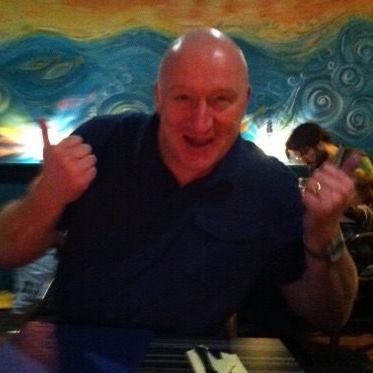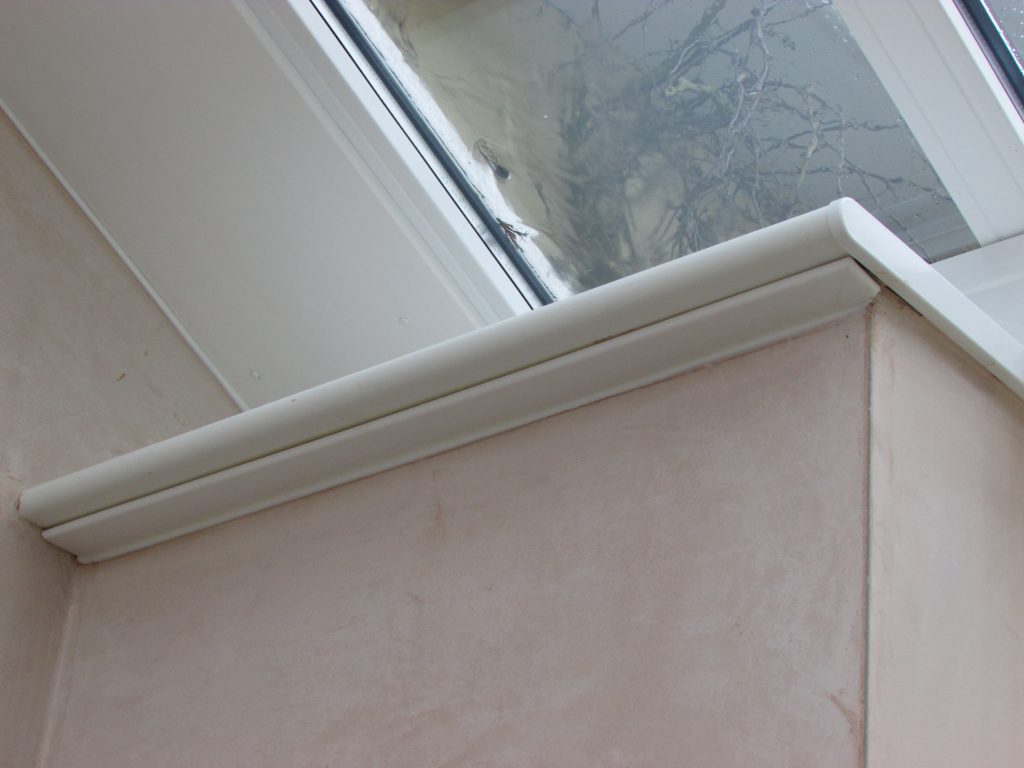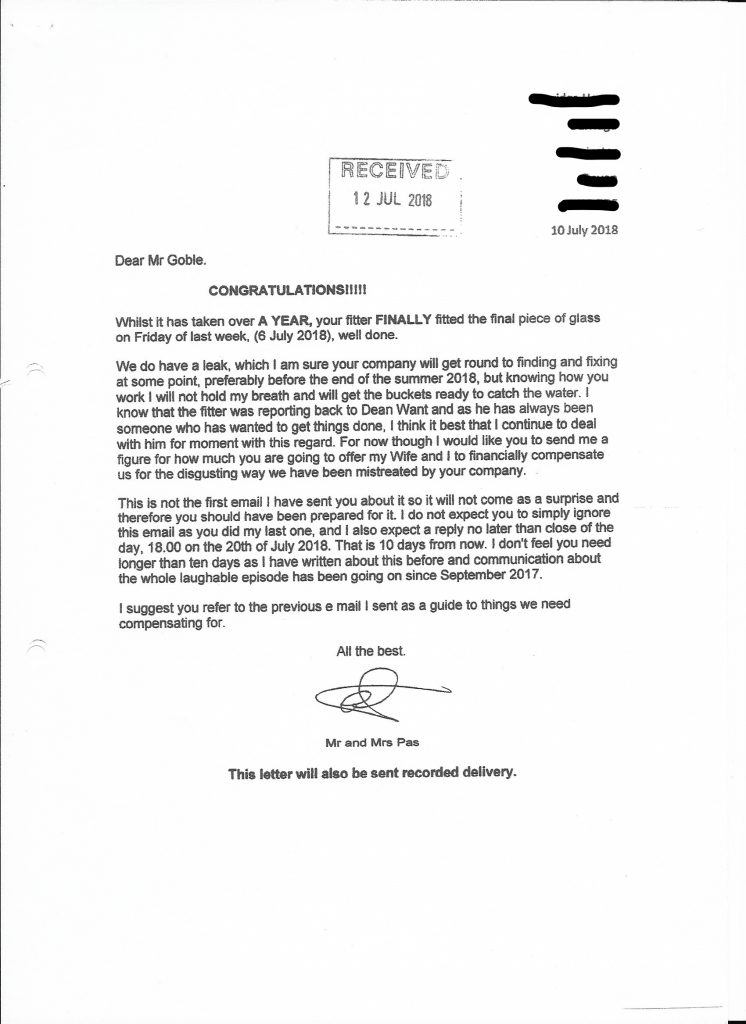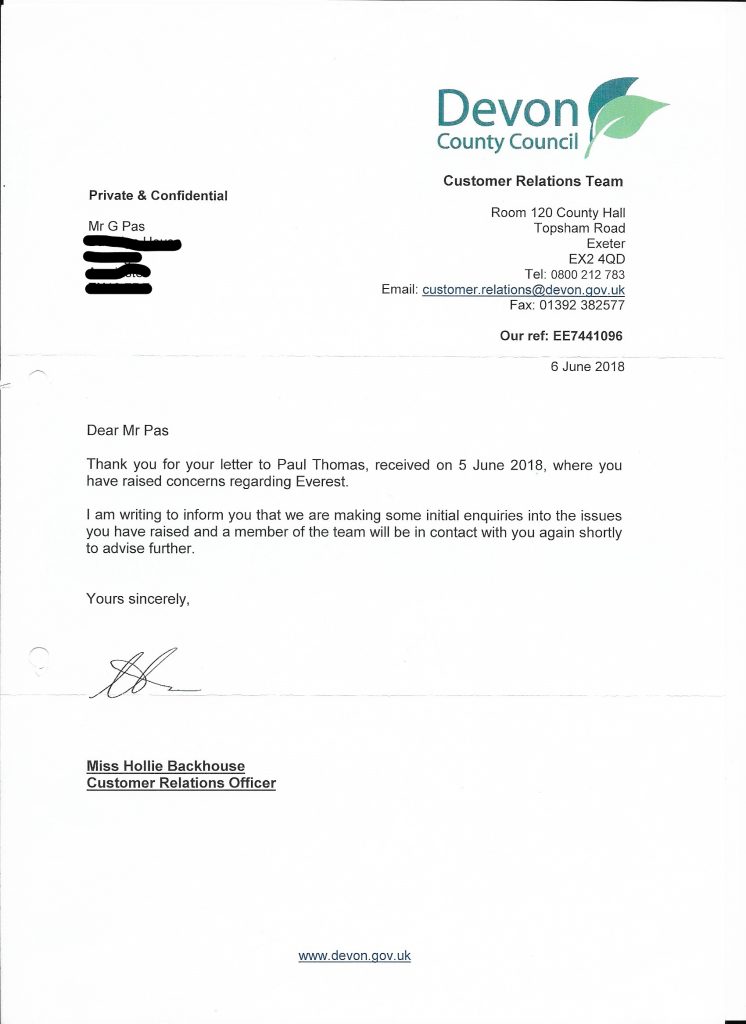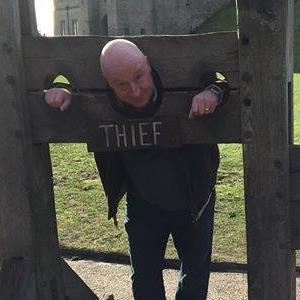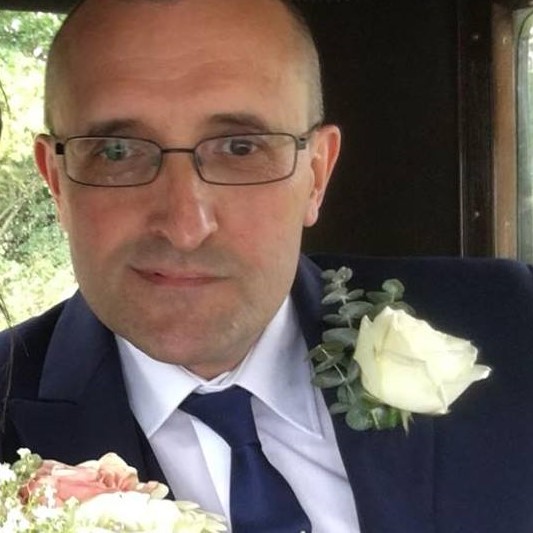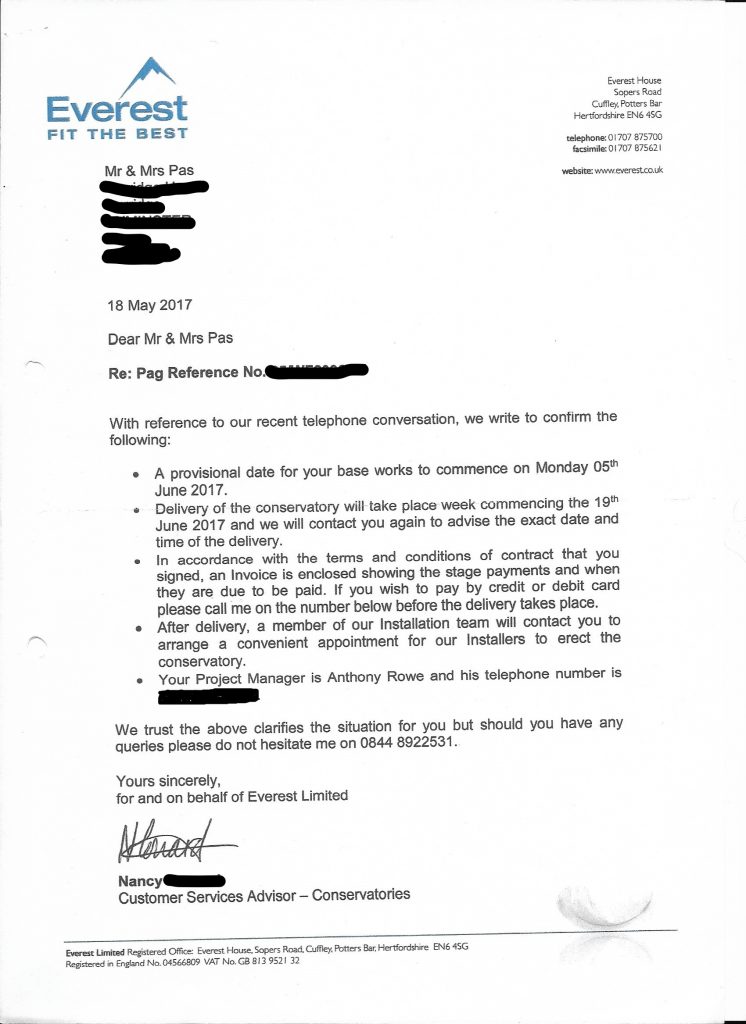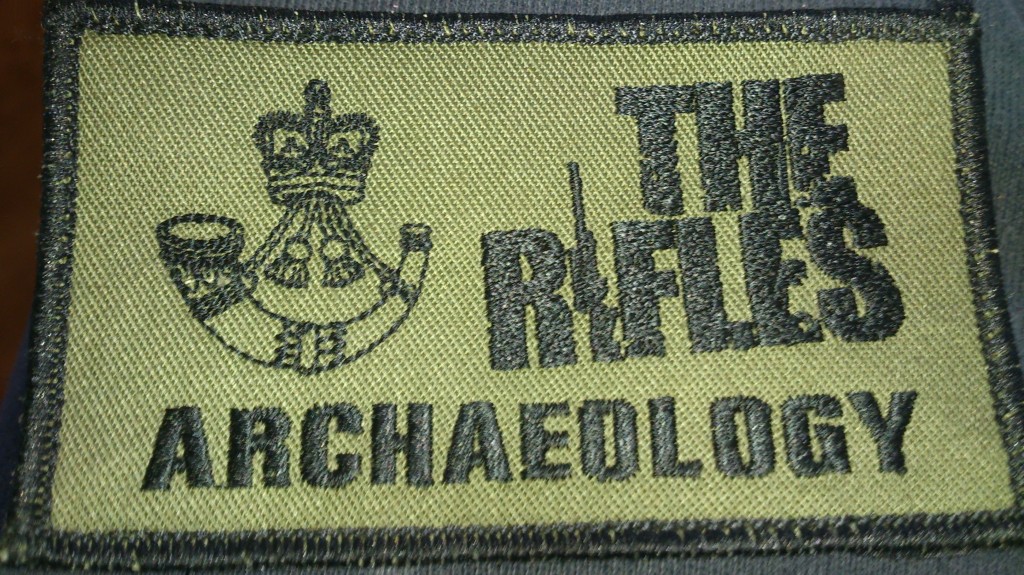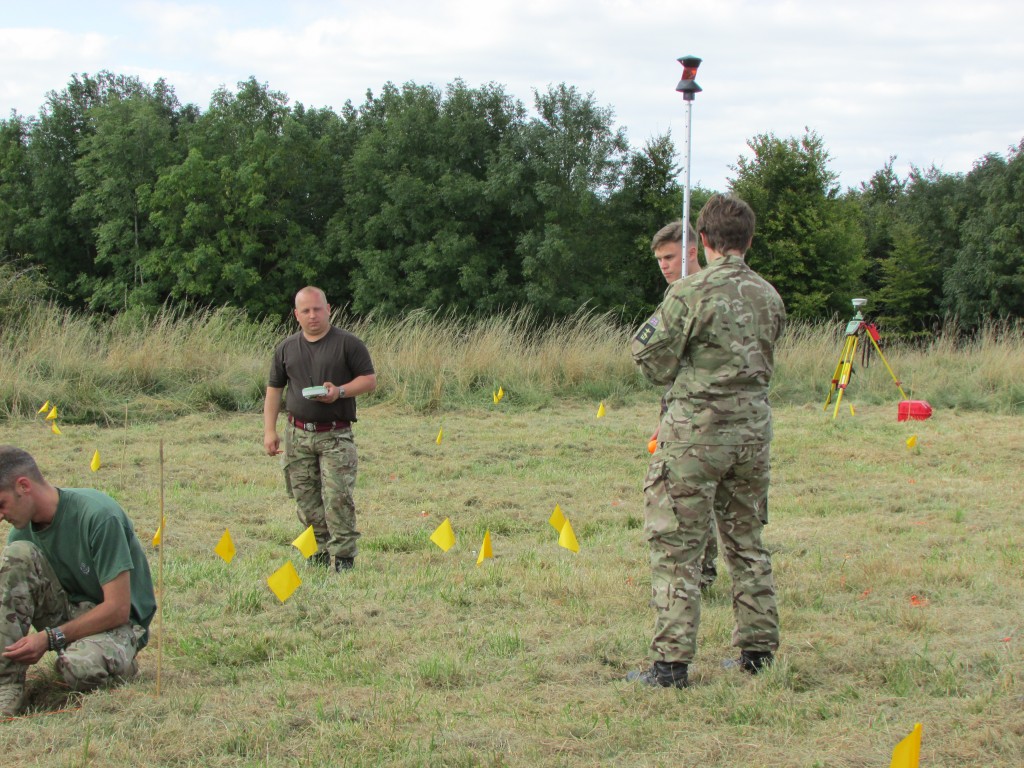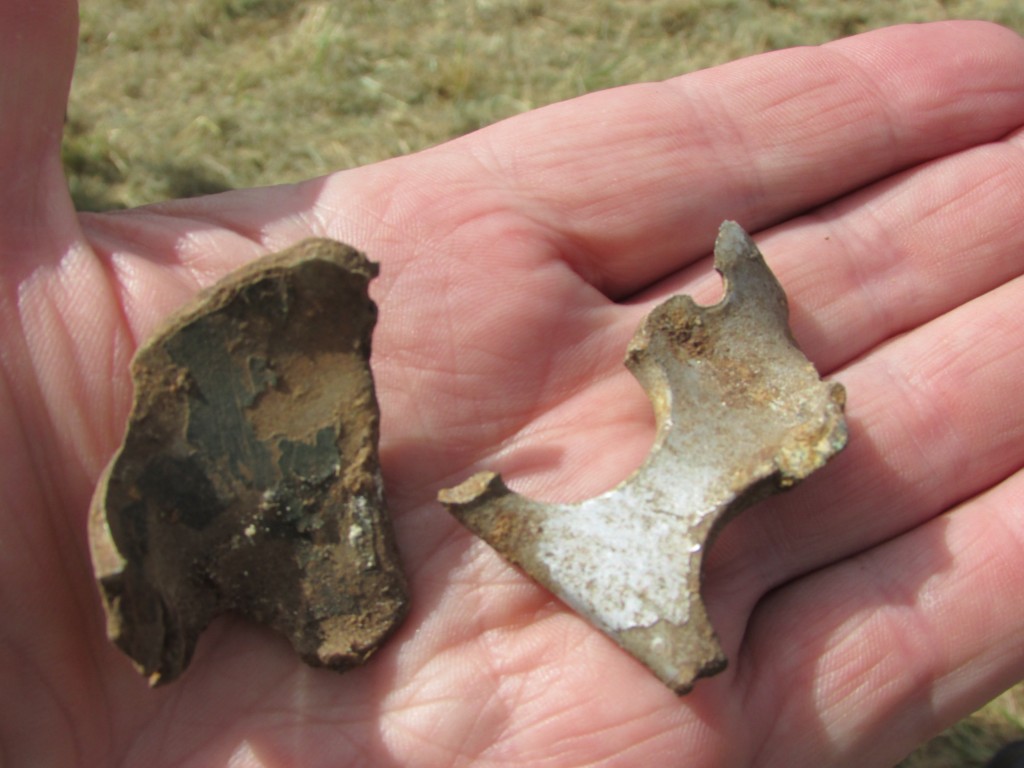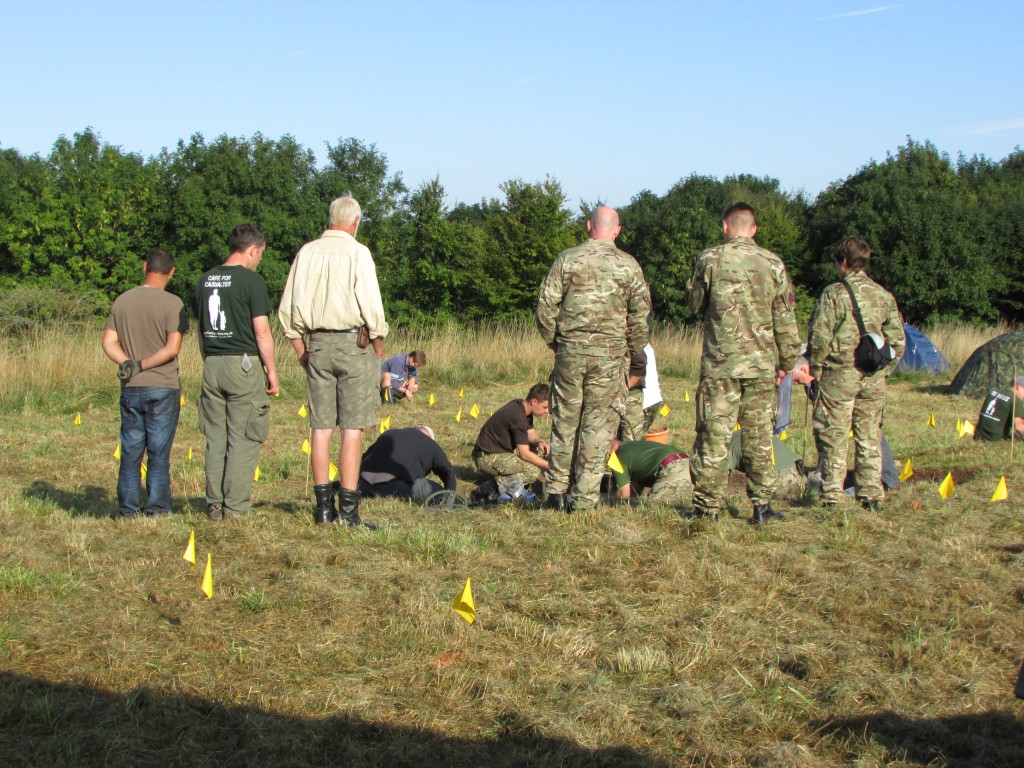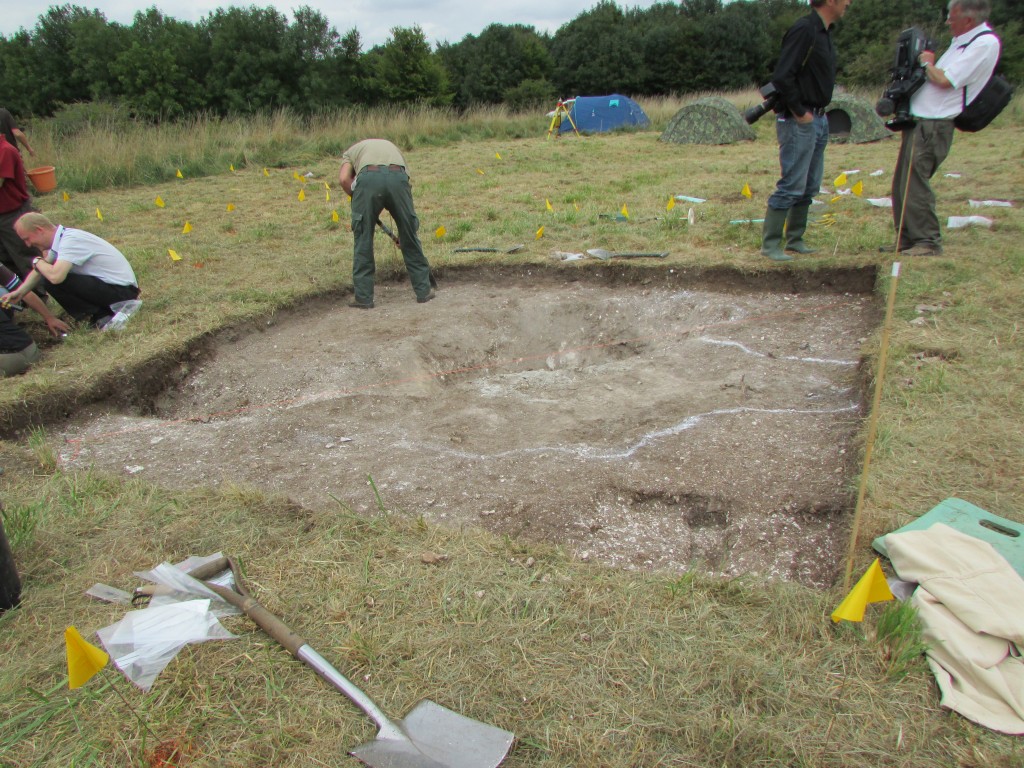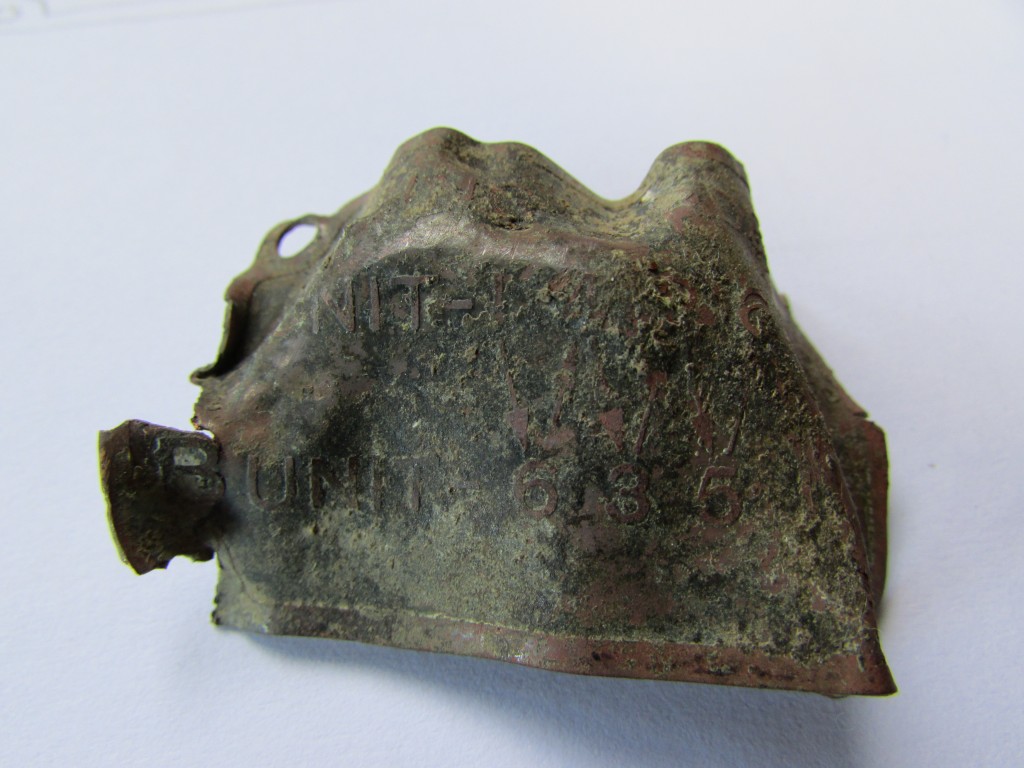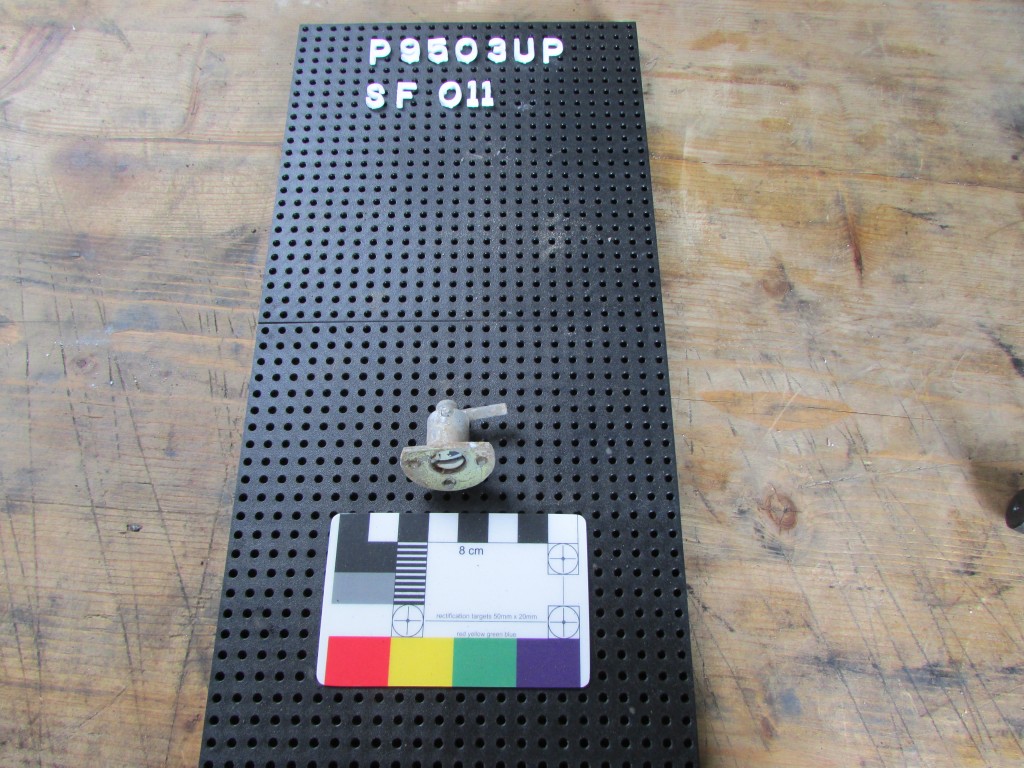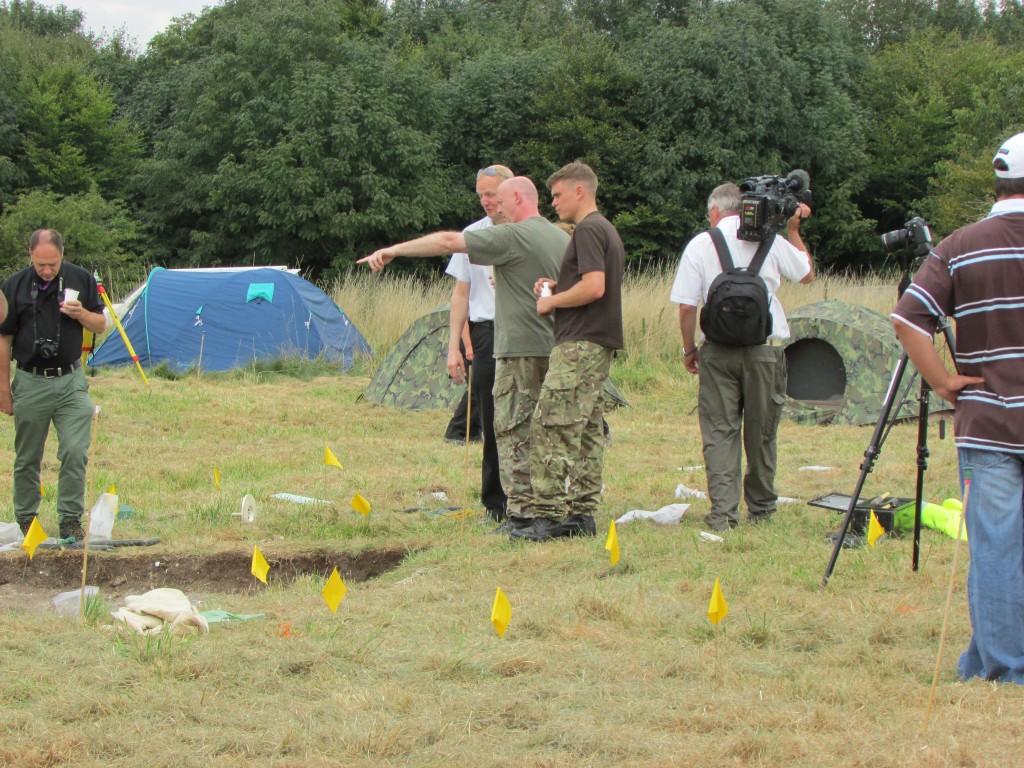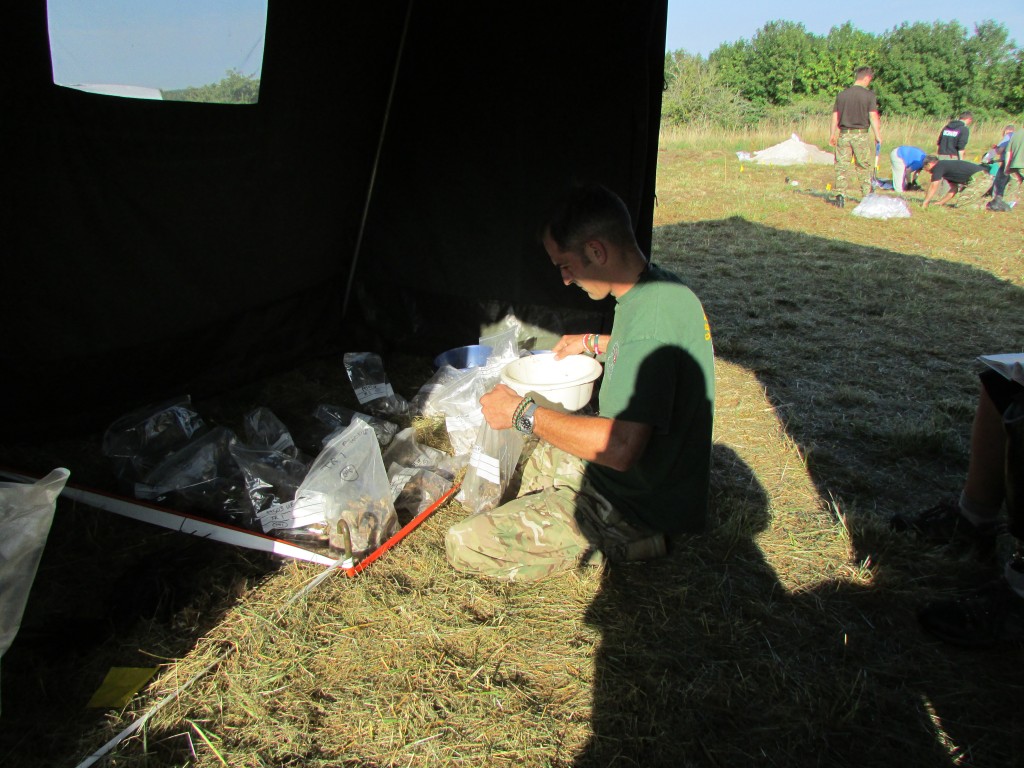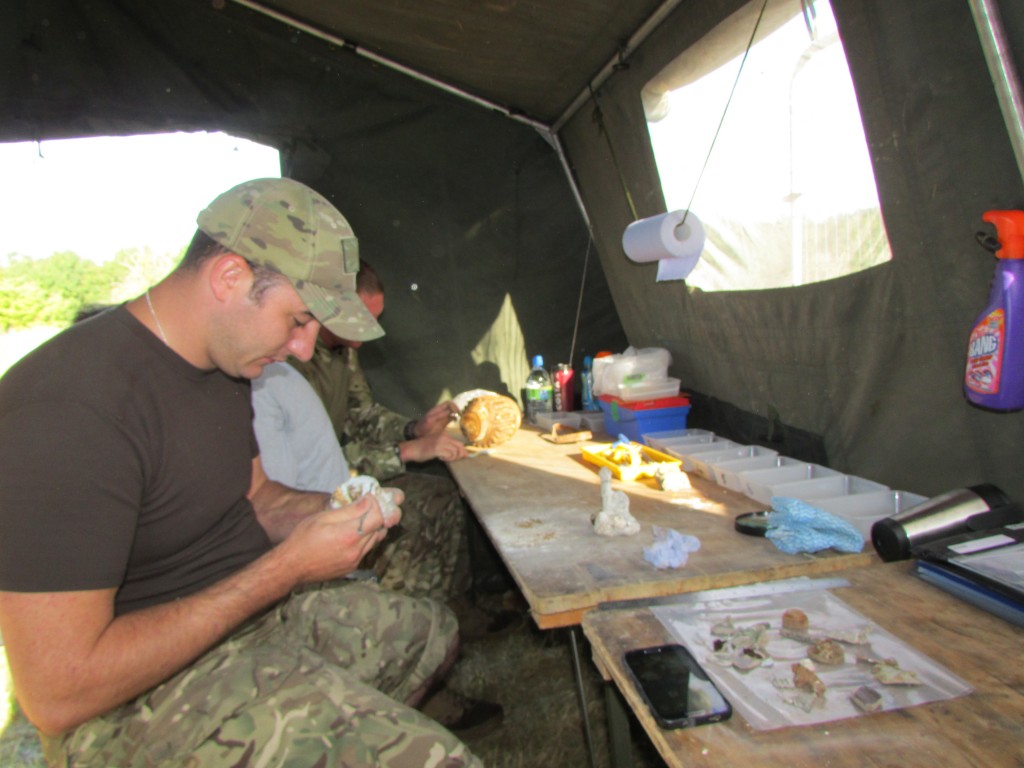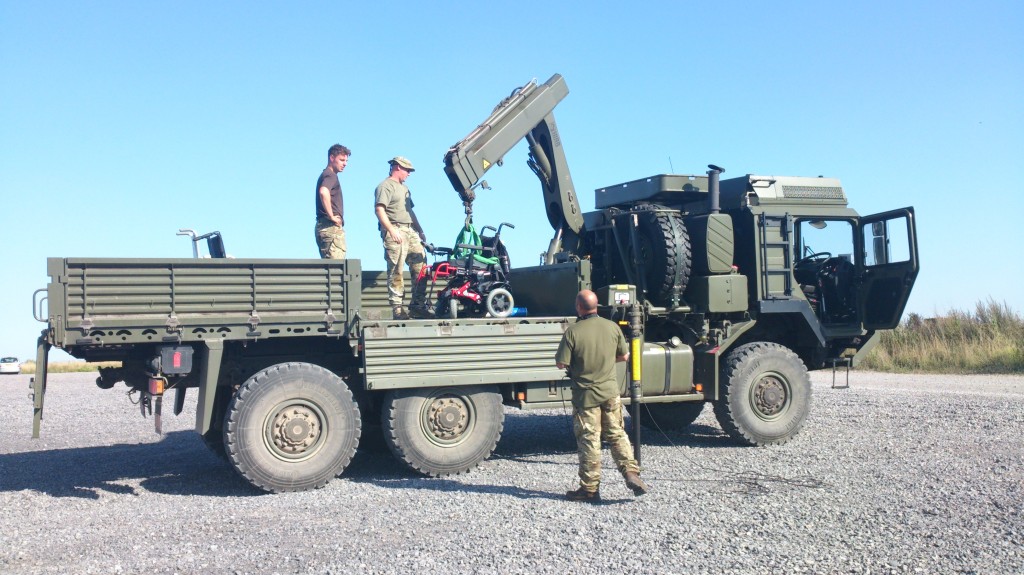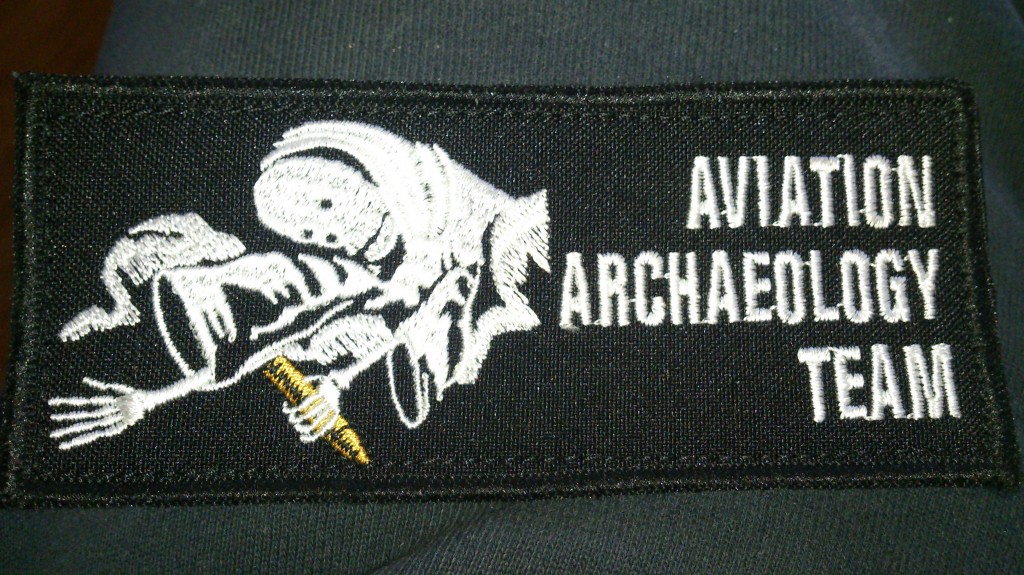I am going to start with pictures from day one and day two as I have been unable to upload any until now, so have a look and see what was going on…
This is how they got my chairs to the dig site….
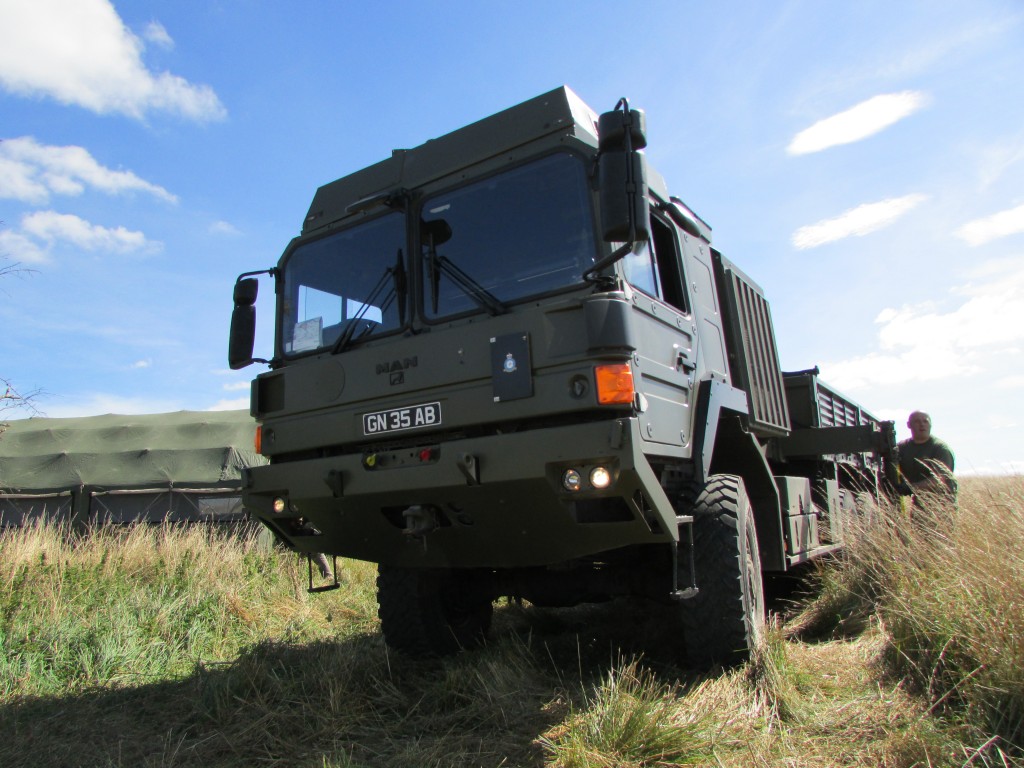 Here they are using metal detectors to find metal and marking the `hits` with flags, this will map the area out and then the digging can start…
Here they are using metal detectors to find metal and marking the `hits` with flags, this will map the area out and then the digging can start…
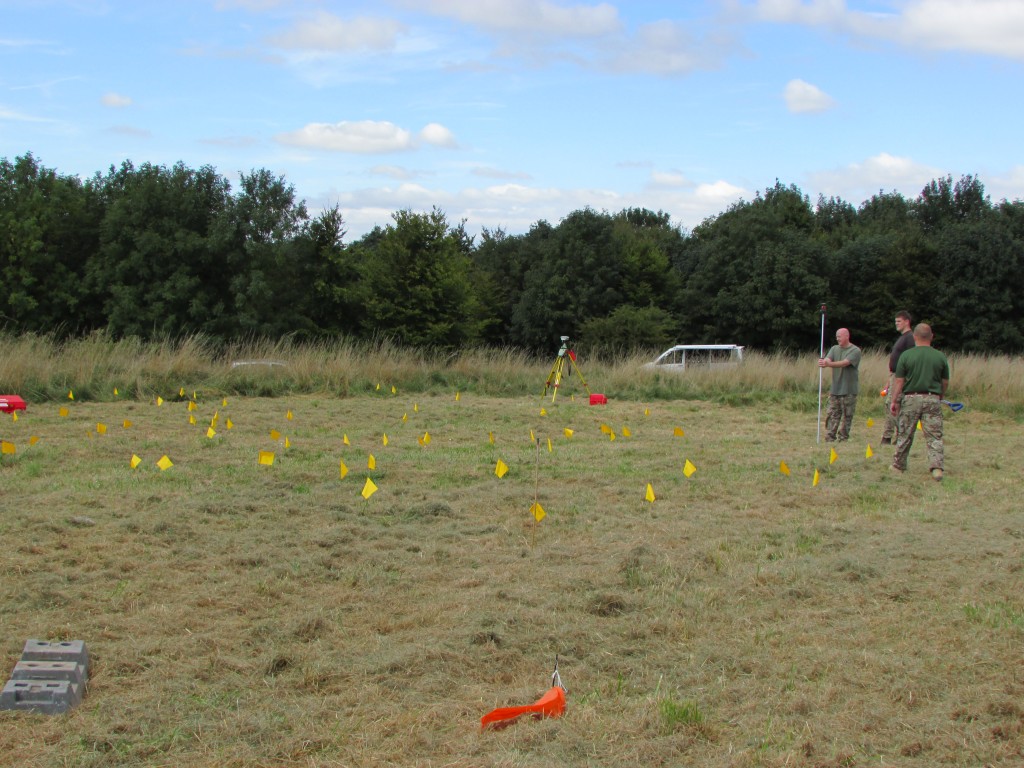 This is the survey team at work, with the equipment they have they can not only find the areas that metal is present but also get a grid location using GPS…
This is the survey team at work, with the equipment they have they can not only find the areas that metal is present but also get a grid location using GPS…
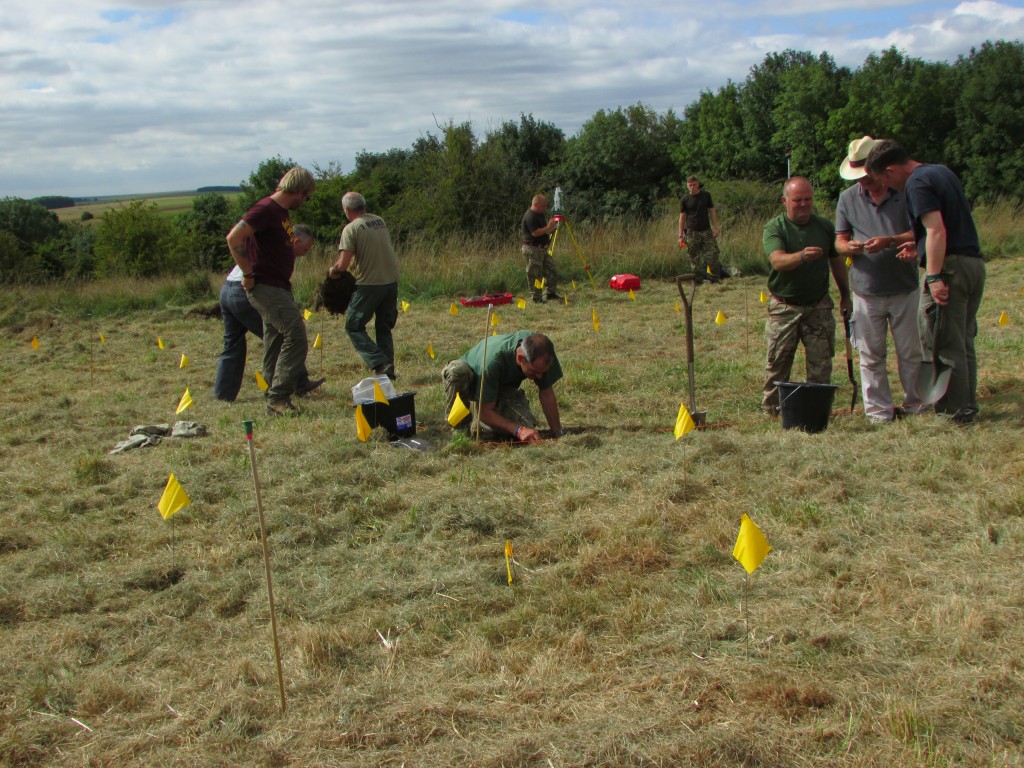 And `finds` are lifted from the ground, on the left hand piece you can actually see the green paint still attached to the metal. This is part of the camouflage colour scheme so this would have been either from the fuselage or upper side wing as the underside of the aircraft was a light colour to blend in with the sky….
And `finds` are lifted from the ground, on the left hand piece you can actually see the green paint still attached to the metal. This is part of the camouflage colour scheme so this would have been either from the fuselage or upper side wing as the underside of the aircraft was a light colour to blend in with the sky….
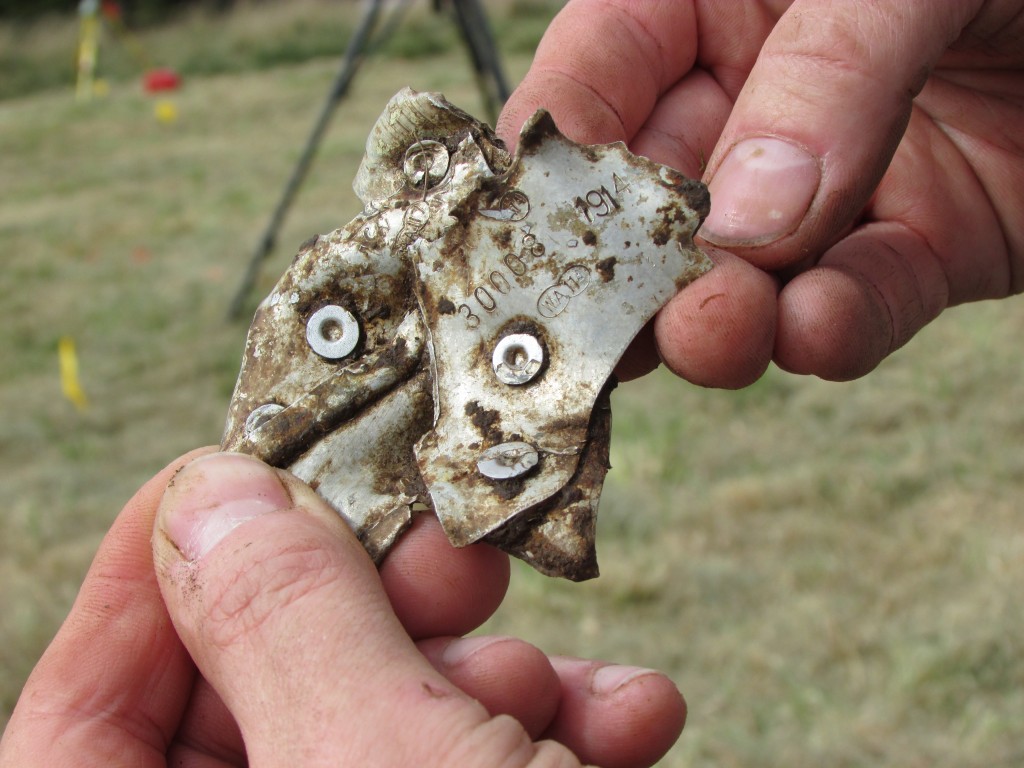 The `finds` are then brought in to me and the `finds team` in the `finds tent`.
The `finds` are then brought in to me and the `finds team` in the `finds tent`.
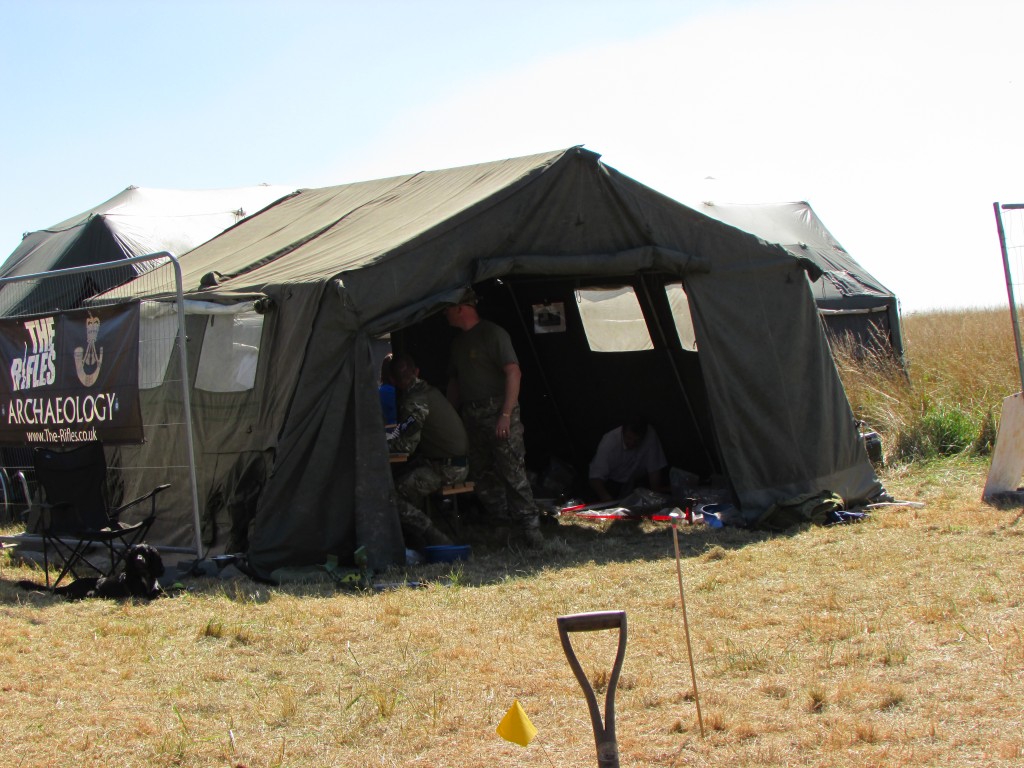 Here the team clean the “finds` and try to locate a serial or part number…
Here the team clean the “finds` and try to locate a serial or part number…
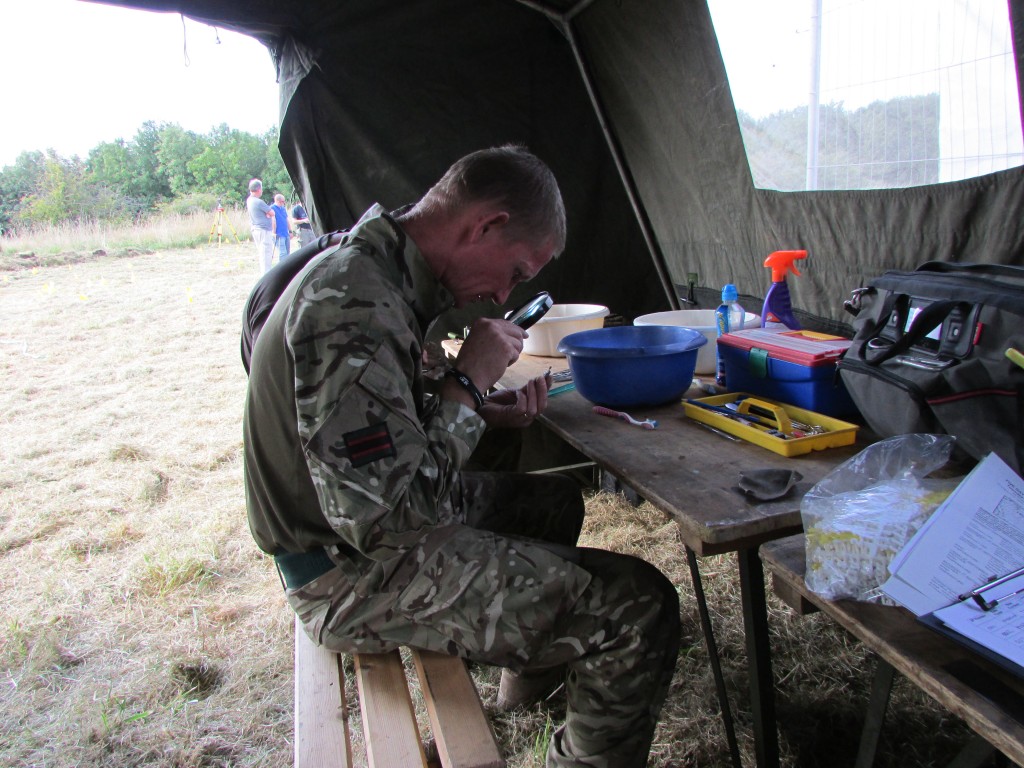 Then hand them to me where I look at the serial or part number if there is one and look it up so that I can tell what it is.
Then hand them to me where I look at the serial or part number if there is one and look it up so that I can tell what it is.
 I then photograph the `find` and give it a unique number which as you can see, is in the photograph. I then write on a log sheet what the item is and all other details about it.
I then photograph the `find` and give it a unique number which as you can see, is in the photograph. I then write on a log sheet what the item is and all other details about it.
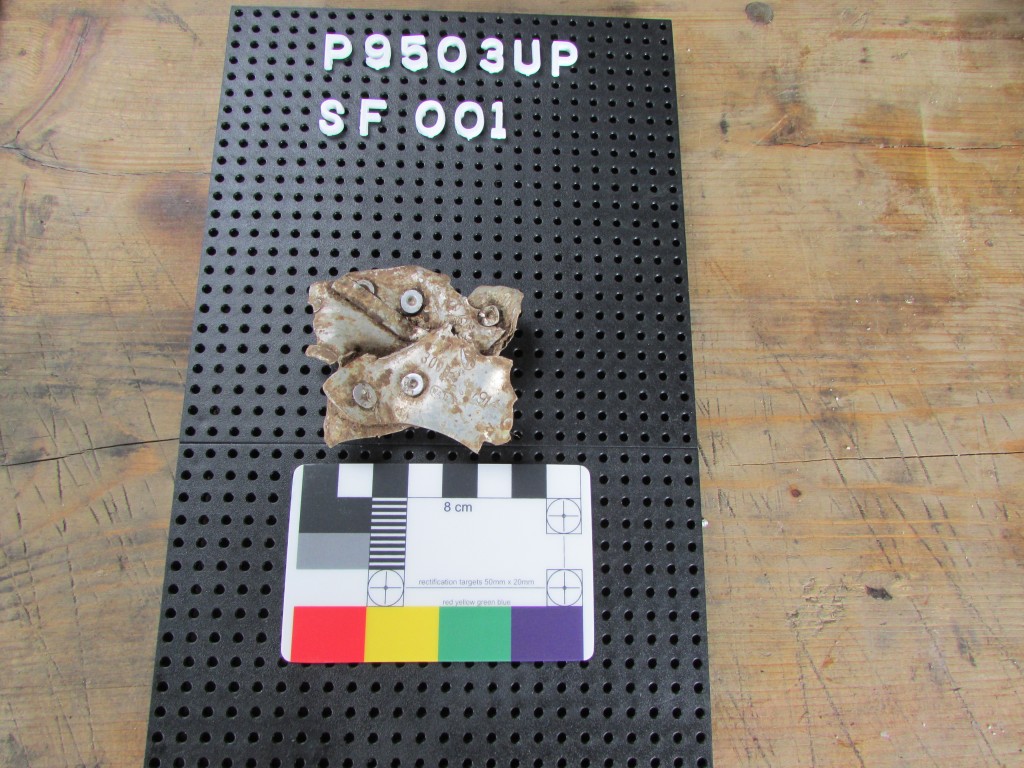 The item is then bagged and put in to a `bay` which relates to the trench it came from.
The item is then bagged and put in to a `bay` which relates to the trench it came from.
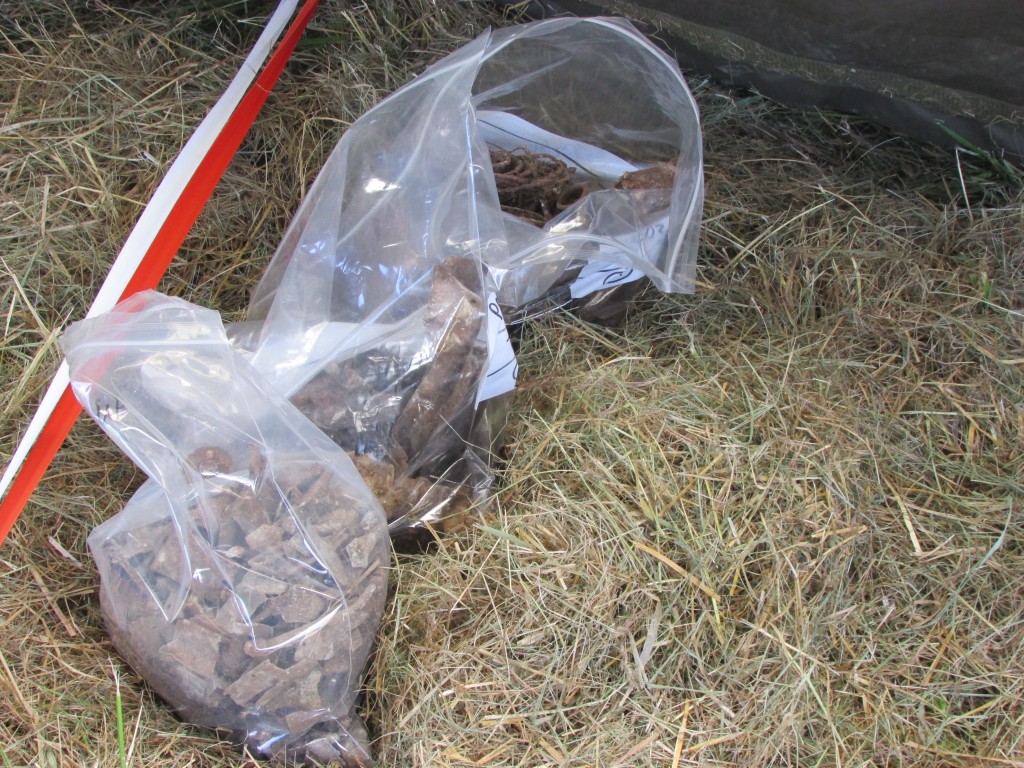 A couple of other items from day one for you to see…
A couple of other items from day one for you to see…
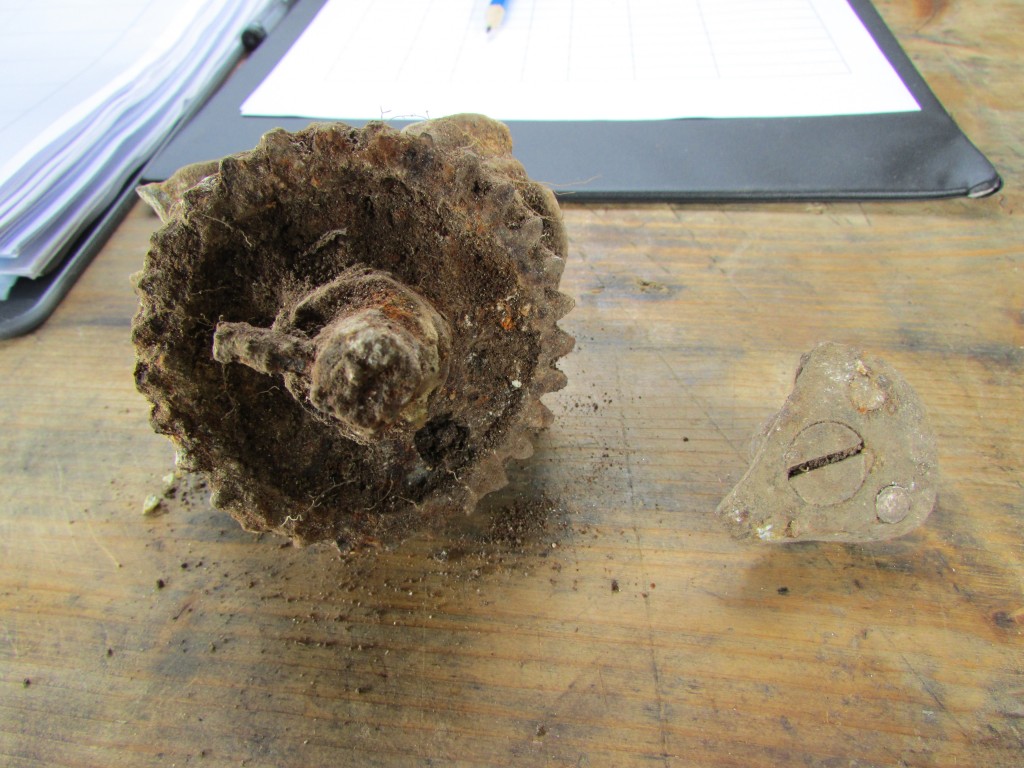
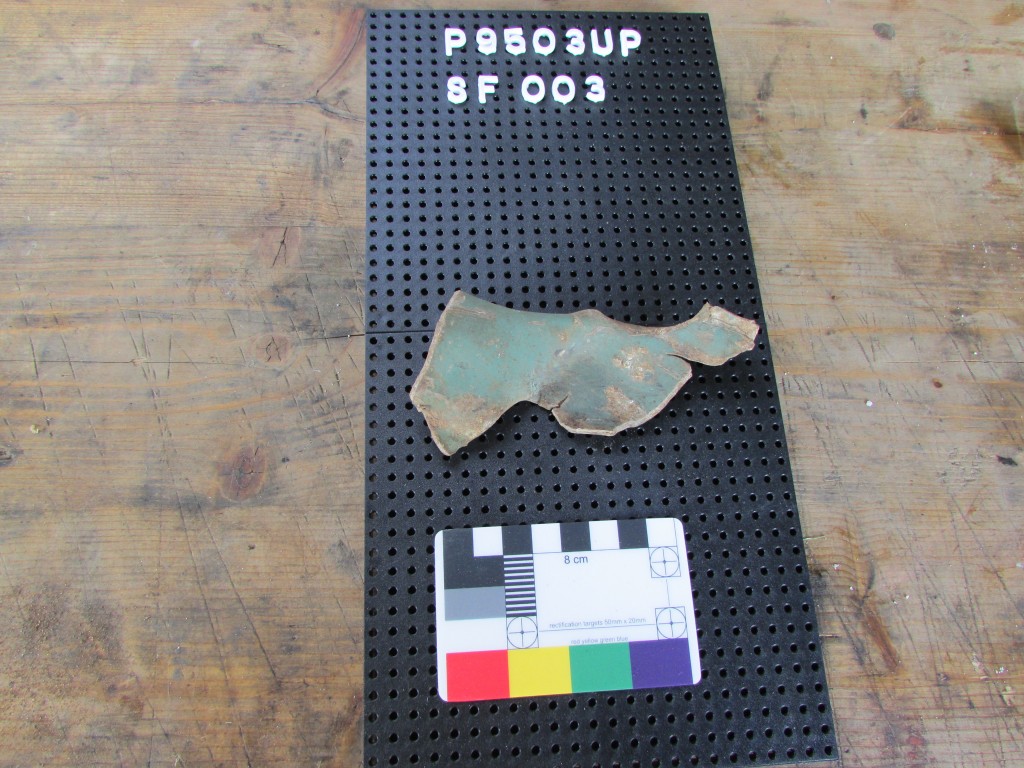 So now some pictures from day two…
So now some pictures from day two…
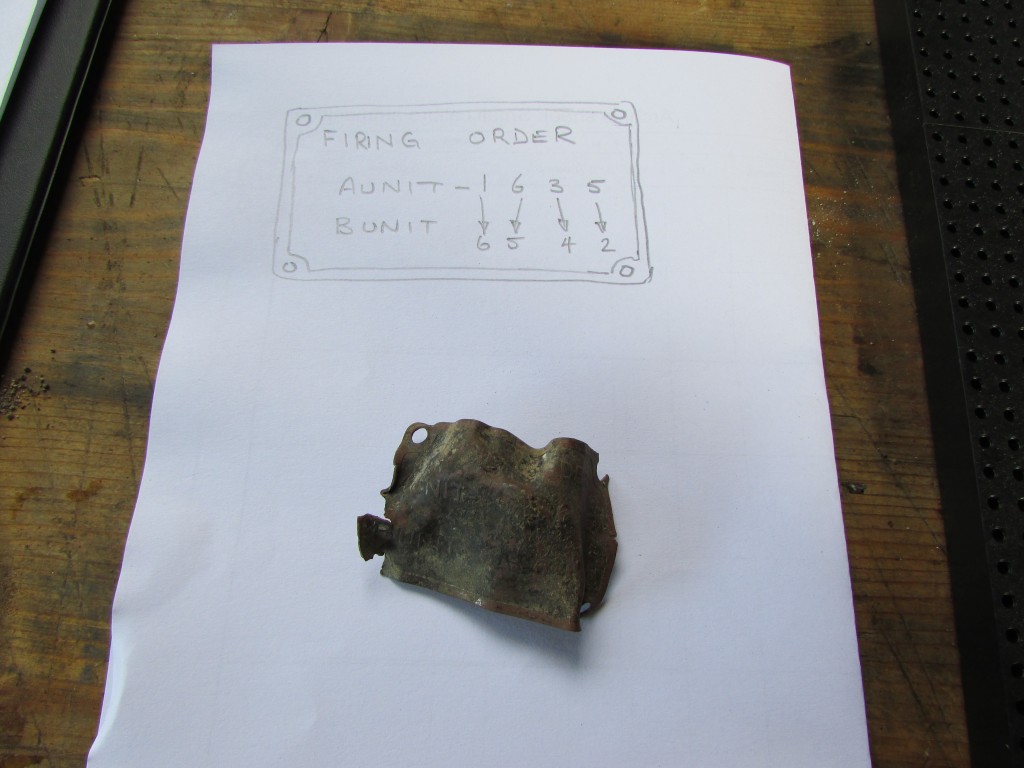 Part of the electrical system…
Part of the electrical system…
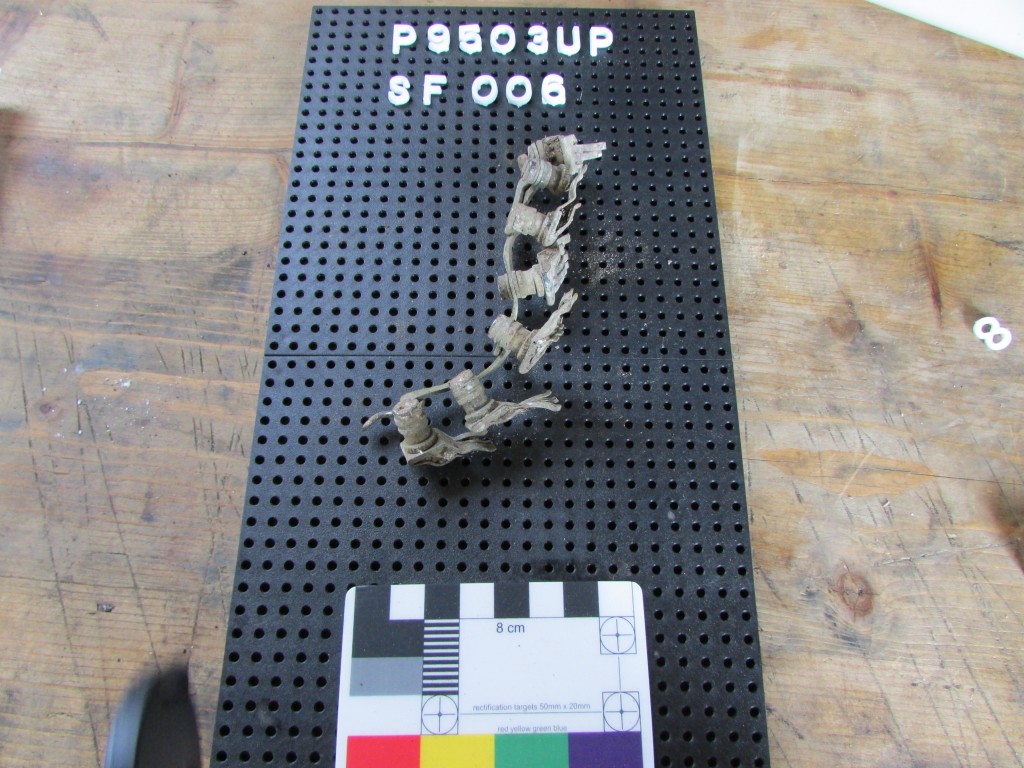 And a cover of some description…
And a cover of some description…
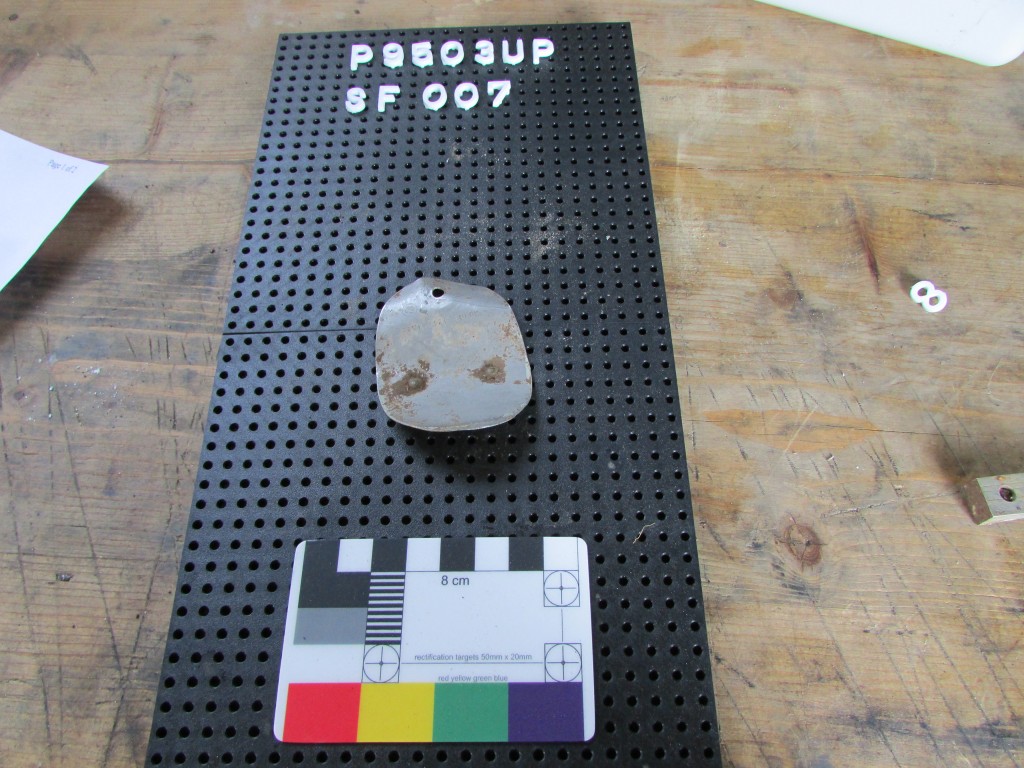 The next part was a release catch for an inspection panel…
The next part was a release catch for an inspection panel…
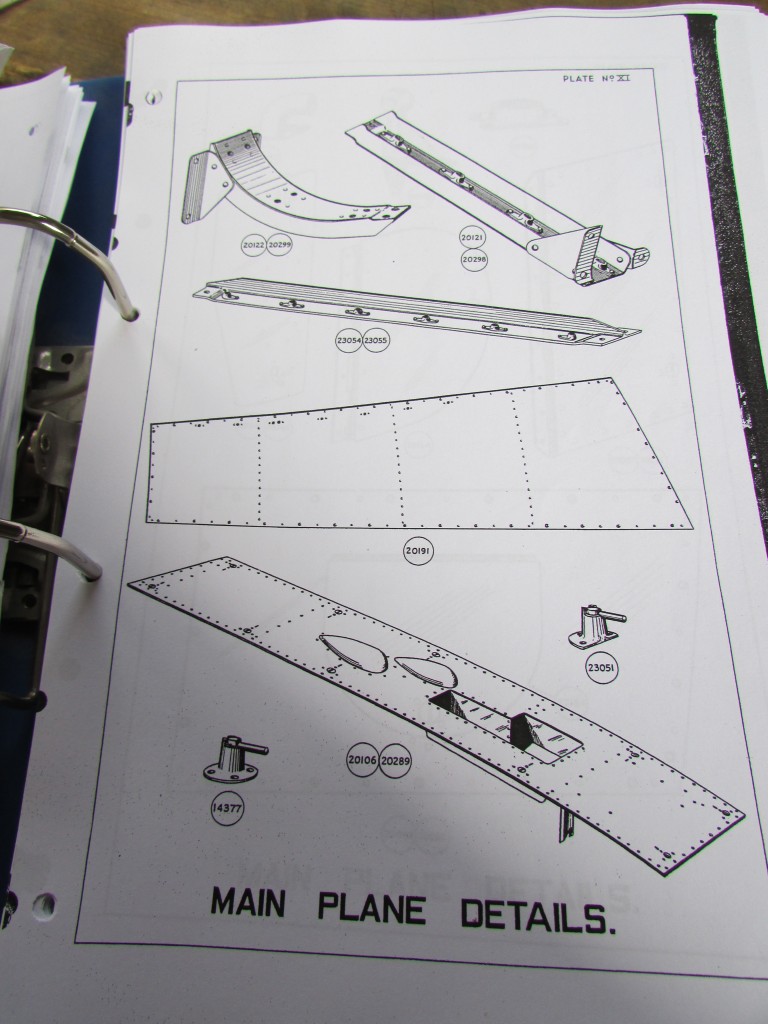 And matched to one of the places it would have potentially been…
And matched to one of the places it would have potentially been…
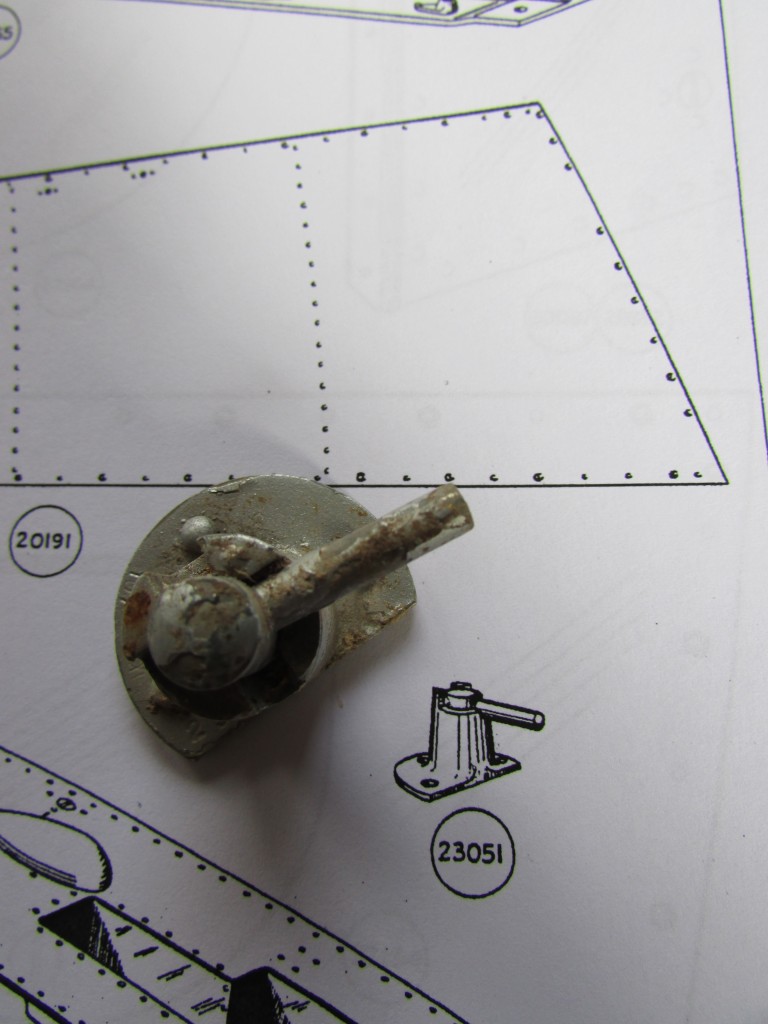 The next piece was really good…
The next piece was really good…
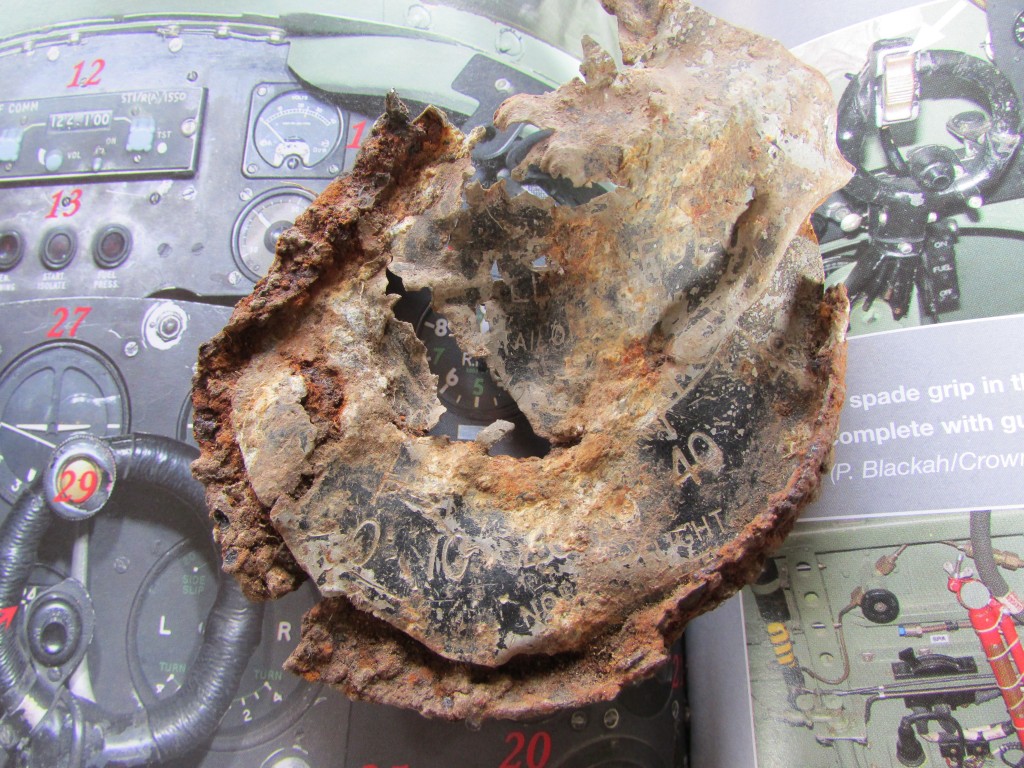 Using a different book I confirmed what I thought it was…
Using a different book I confirmed what I thought it was…
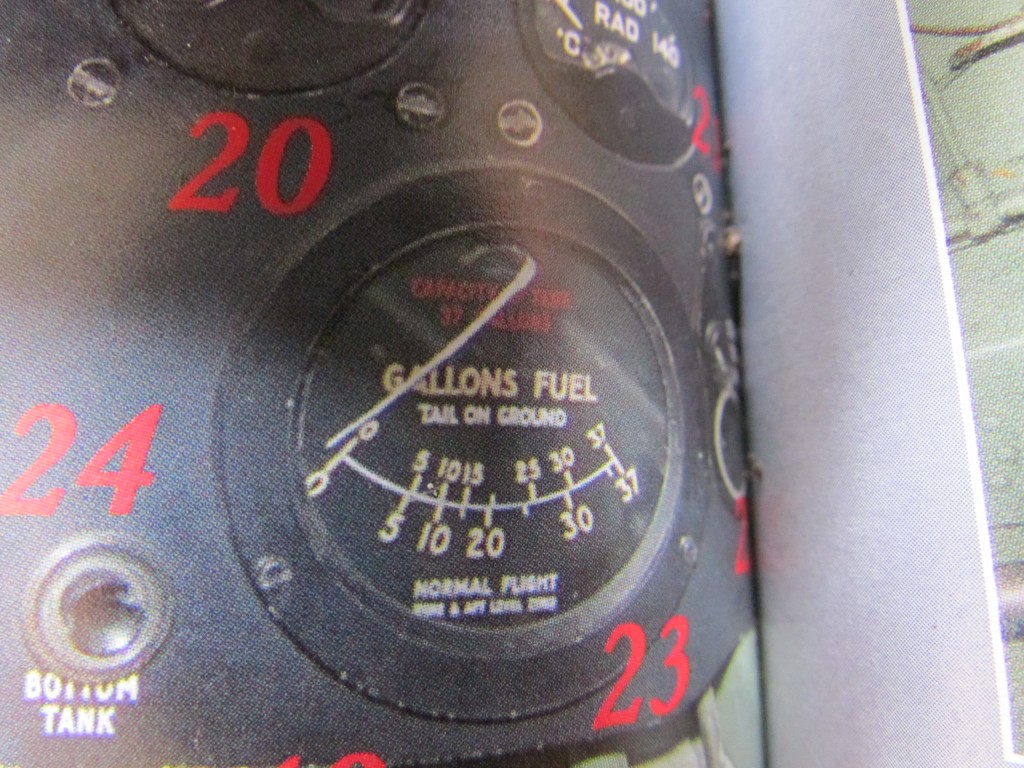 It was the fuel gage from the Spitfire, amazing! So it was logged, photographed and bagged…
It was the fuel gage from the Spitfire, amazing! So it was logged, photographed and bagged…
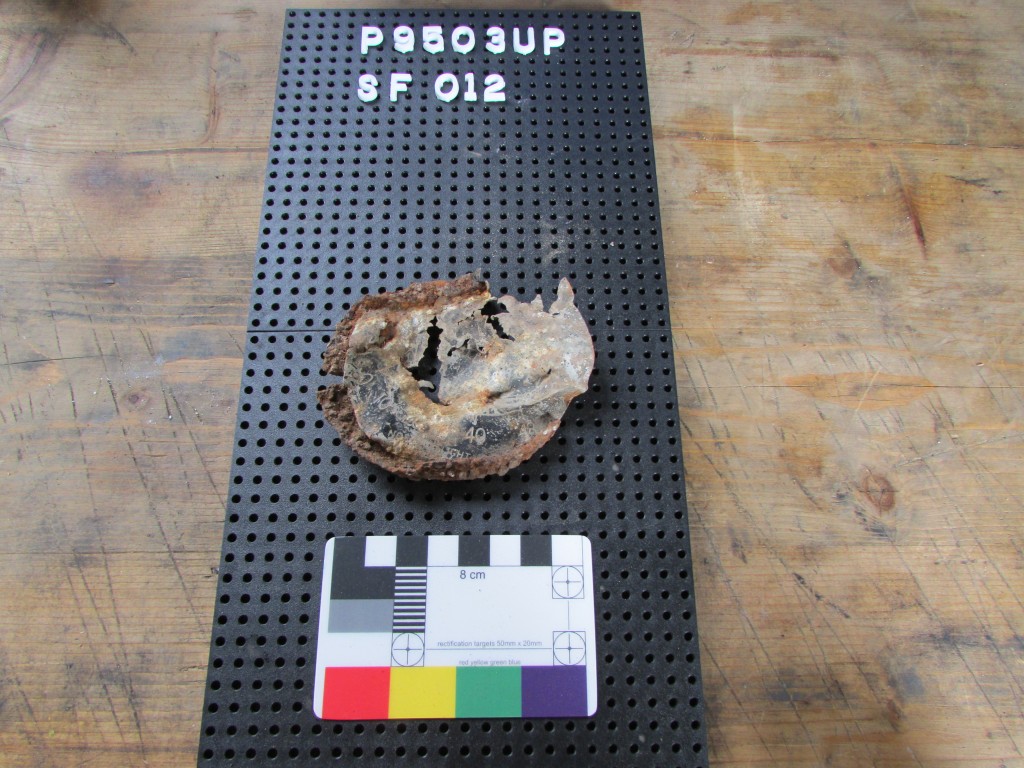 “What the hell is that?” we heard from inside the tent…
“What the hell is that?” we heard from inside the tent…
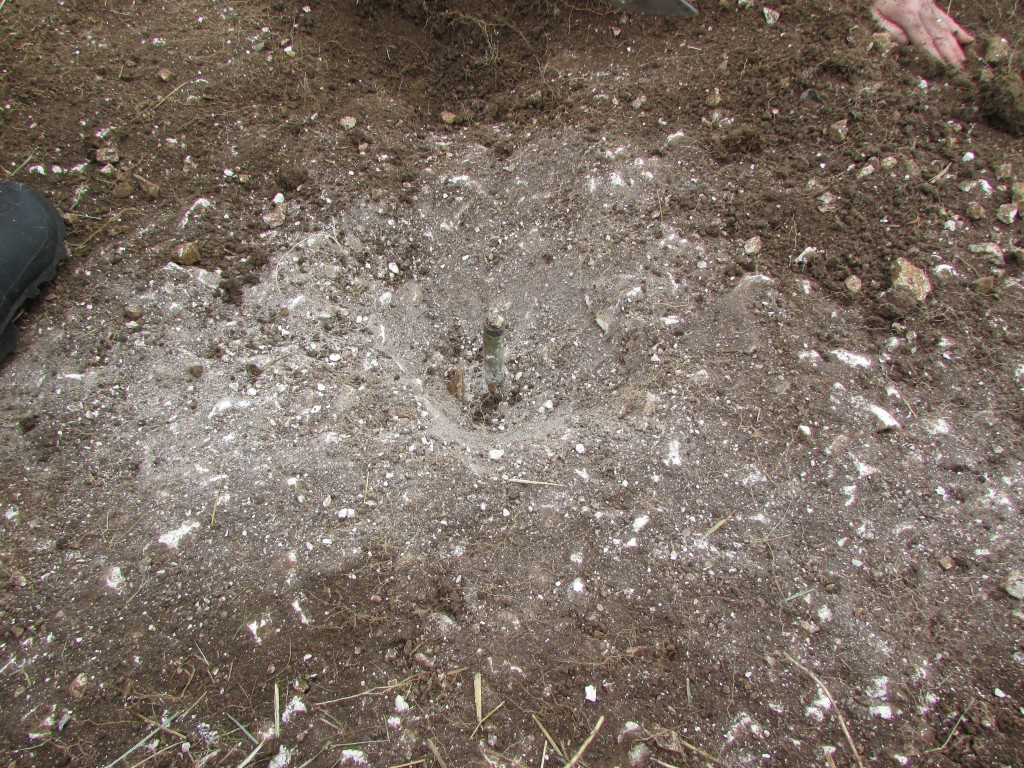 Now save the silly comments, simply chuckle to yourselves…
Now save the silly comments, simply chuckle to yourselves…
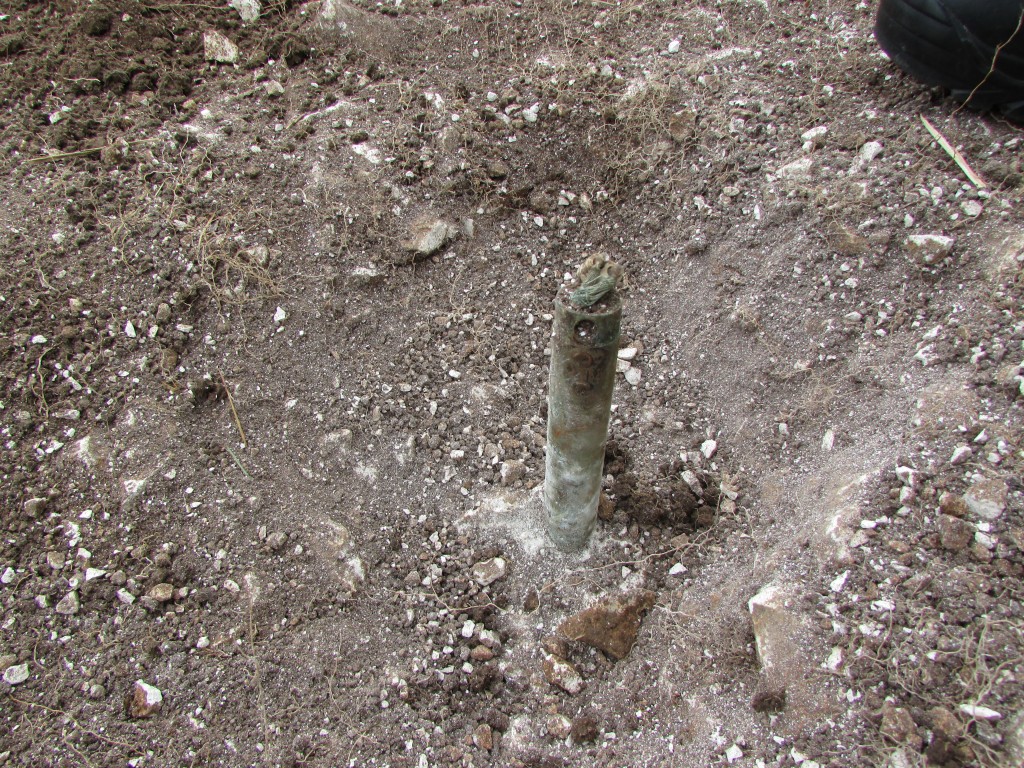 This was an item that orientated the aircraft as this is the Pitot tube which would have been on the left wing. It also shows that the aircraft went in nose first. Then after digging down a few feet this was discovered…
This was an item that orientated the aircraft as this is the Pitot tube which would have been on the left wing. It also shows that the aircraft went in nose first. Then after digging down a few feet this was discovered…
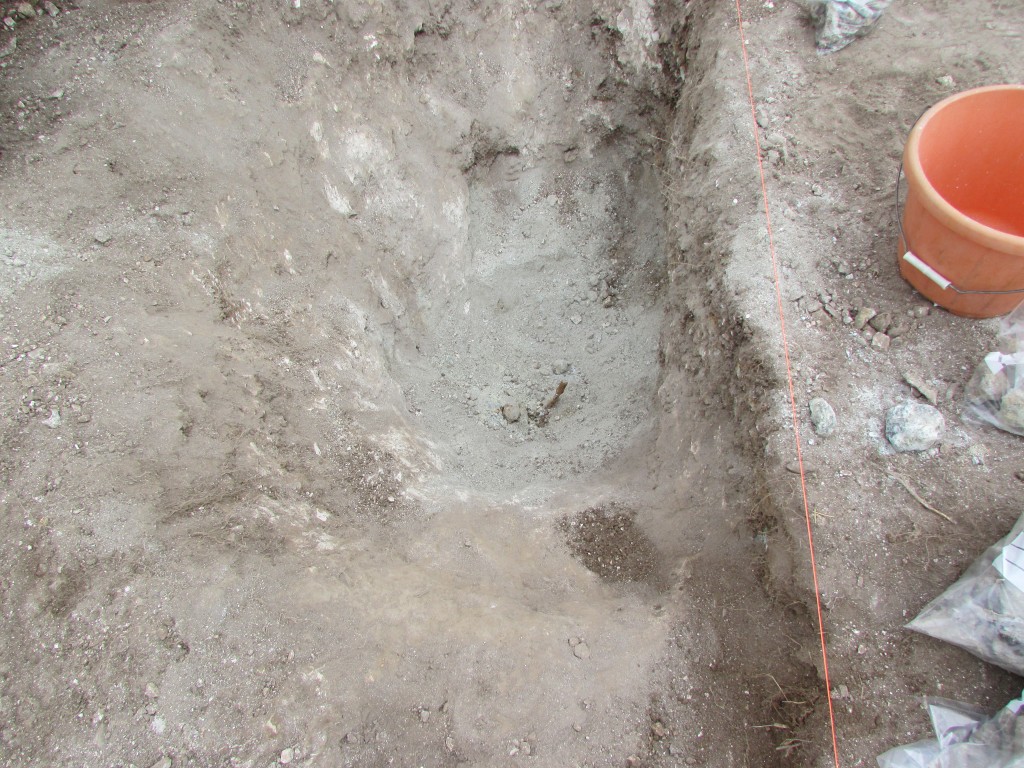 Which caused a stir, and excited the media who were visiting…
Which caused a stir, and excited the media who were visiting…
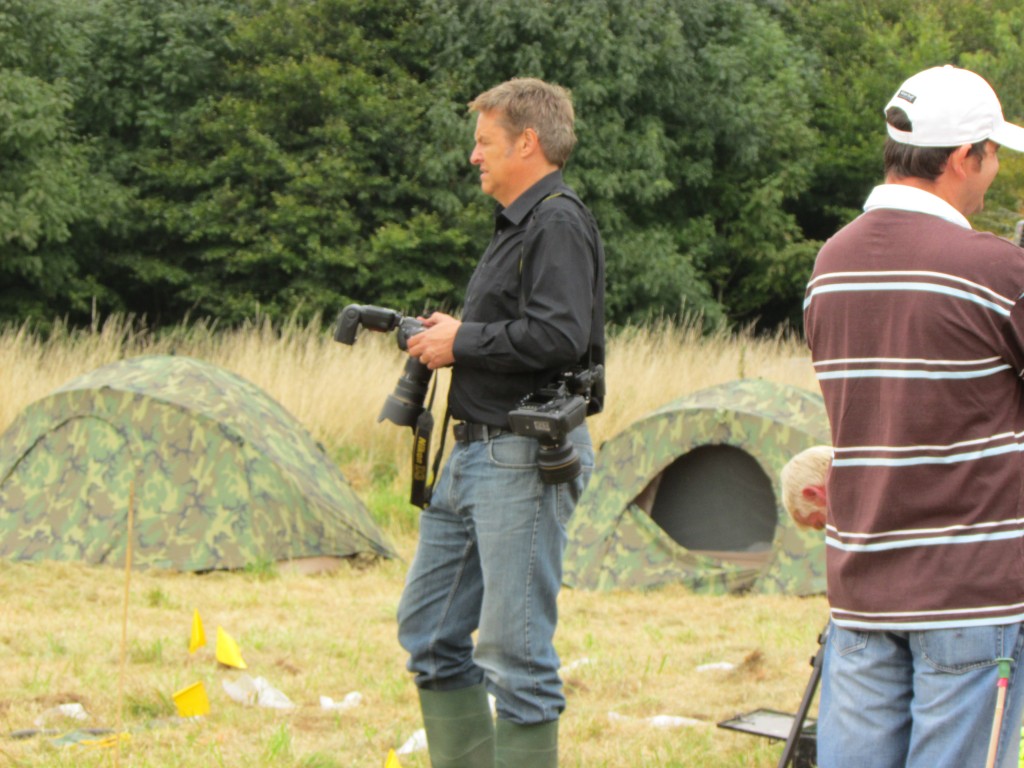
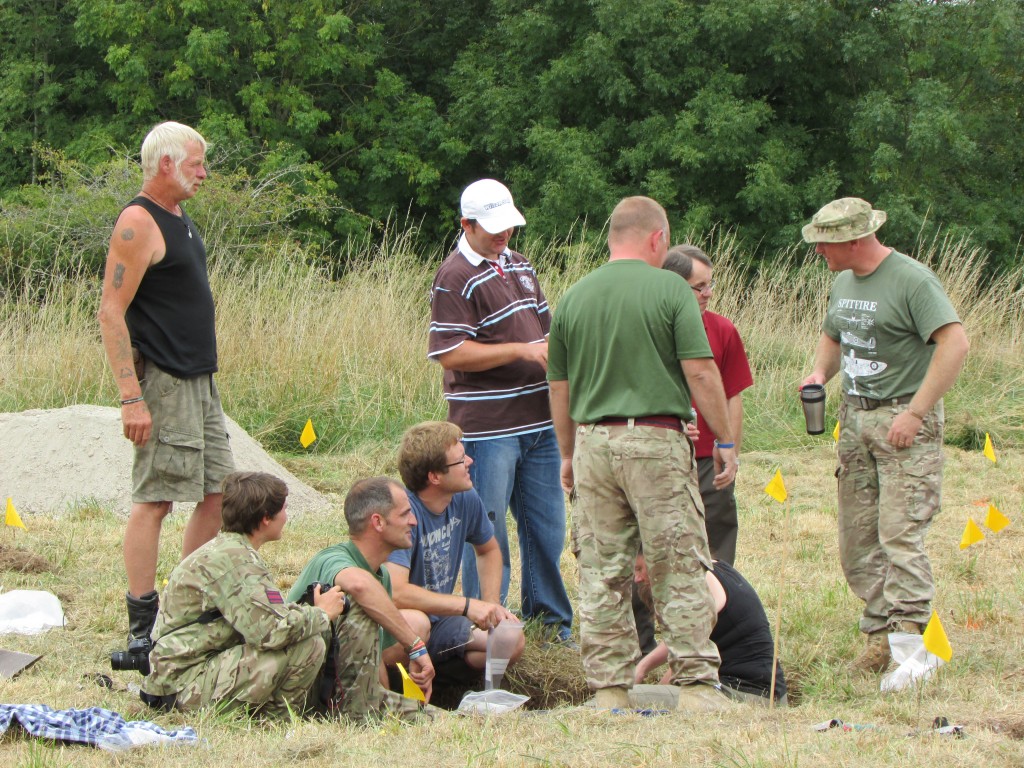
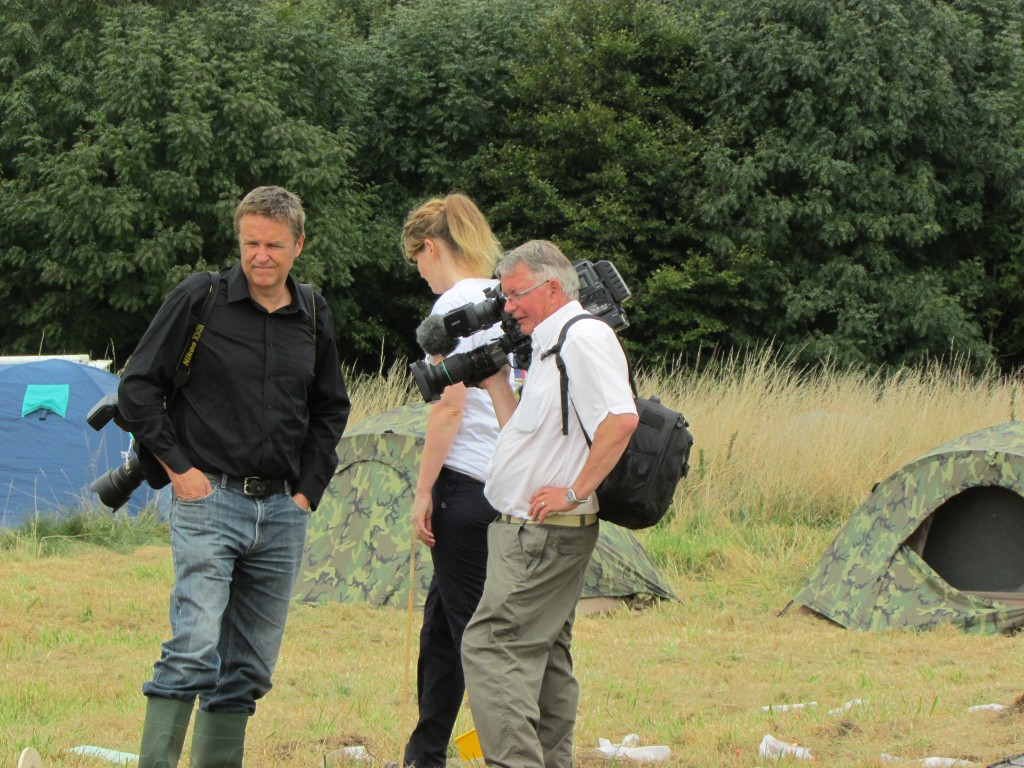 Meanwhile, back in the `finds tent`, the recovered Pitot tube…
Meanwhile, back in the `finds tent`, the recovered Pitot tube…
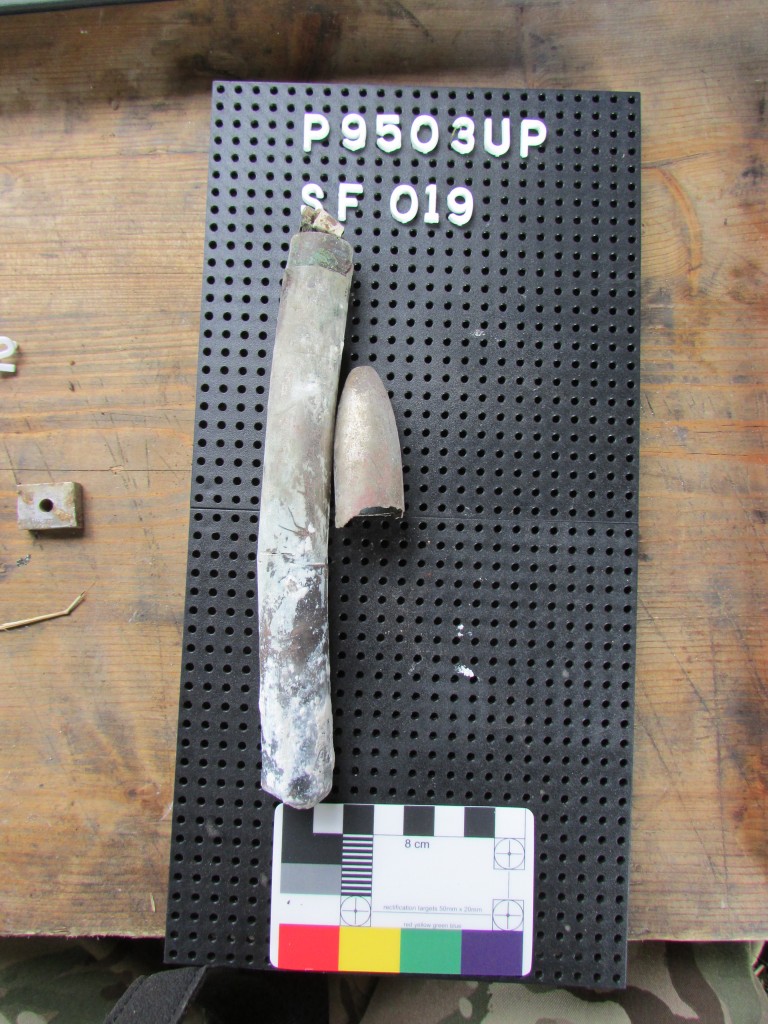 And a plate with some writing to discover what it was for and where it was from which as you can clearly see was from the radio unit. This radio that the pilot would have sent his contact report and his last transmission before bailing out…
And a plate with some writing to discover what it was for and where it was from which as you can clearly see was from the radio unit. This radio that the pilot would have sent his contact report and his last transmission before bailing out…
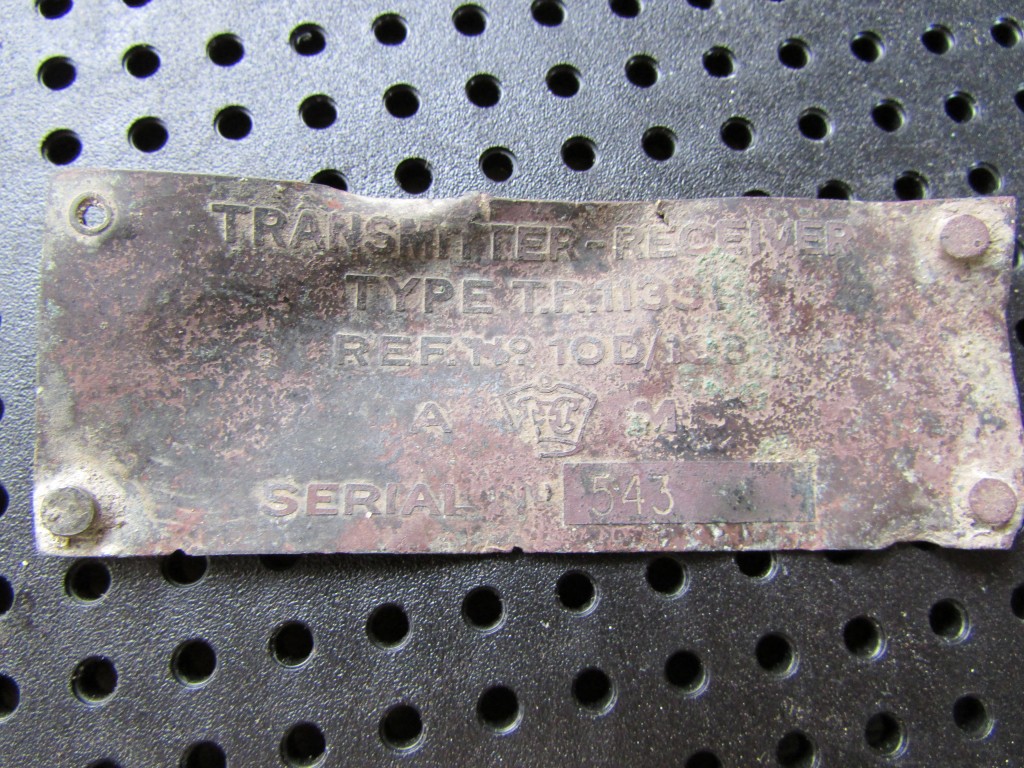 A gasket from somewhere, could it be from the manifold maybe?…
A gasket from somewhere, could it be from the manifold maybe?…
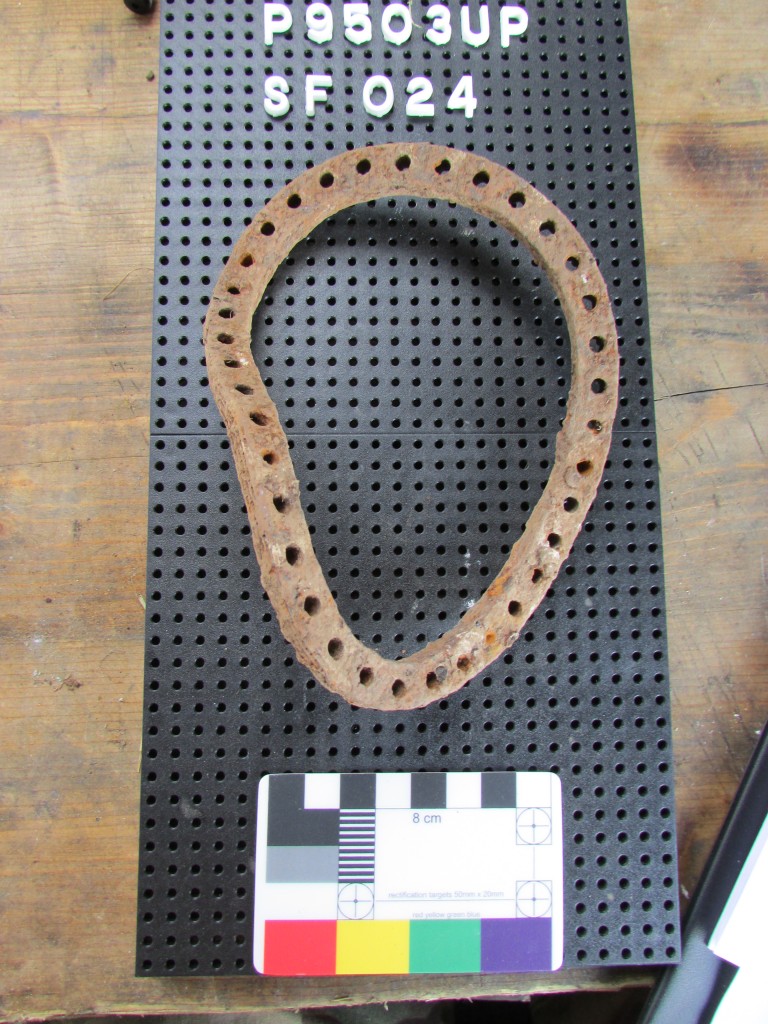 And this which was half of a cog. I looked in the engine manual and discovered where this had come from. Stupidly though I forgot to write down for my own notes and now can not remember where it was from, bugger!…
And this which was half of a cog. I looked in the engine manual and discovered where this had come from. Stupidly though I forgot to write down for my own notes and now can not remember where it was from, bugger!…
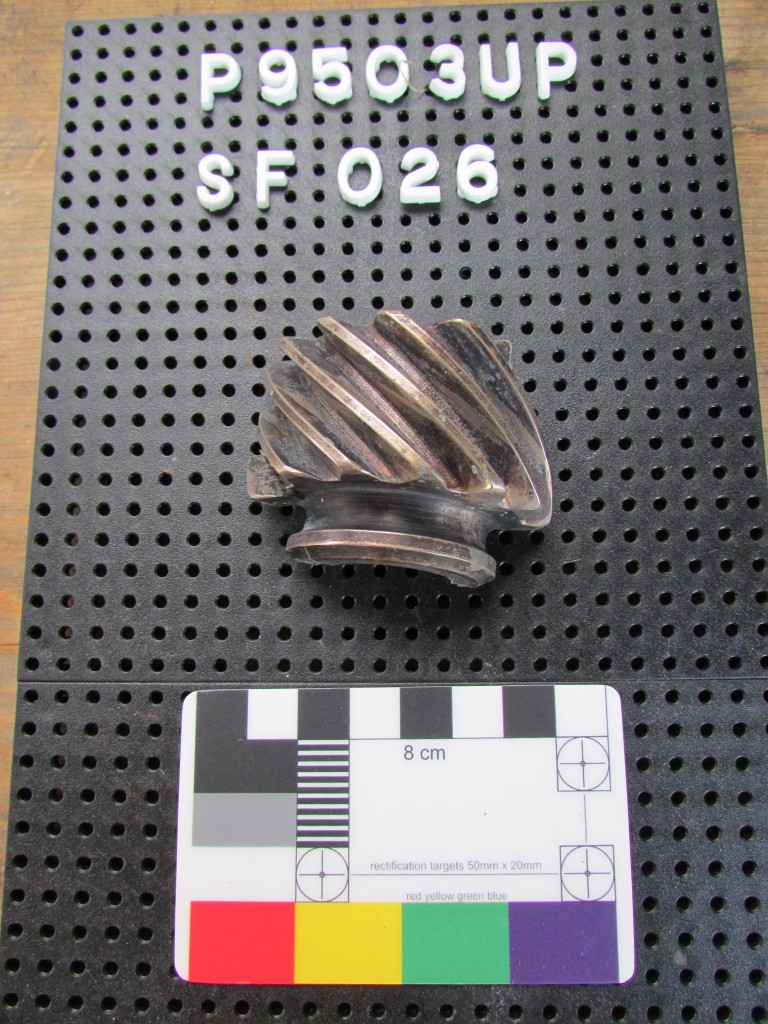 As well as the press we had a very special guest, her name is Rosemary and she is the Daughter of the pilot who was flying this Spitfire. He, as I said before unfortunately died in another engagement three months before Rosemary was born, she spent all day with us on site and helped in the `finds tent` cleaning items. One of the items was the release catch of the canopy which would have been one of the last things that her father had touched before leaving the stricken fighter aircraft. It was an absolute delight to spend time with Rosemary, and I think that from what she was saying, she was delighted that we had tracked her down and invited her to visit us.
As well as the press we had a very special guest, her name is Rosemary and she is the Daughter of the pilot who was flying this Spitfire. He, as I said before unfortunately died in another engagement three months before Rosemary was born, she spent all day with us on site and helped in the `finds tent` cleaning items. One of the items was the release catch of the canopy which would have been one of the last things that her father had touched before leaving the stricken fighter aircraft. It was an absolute delight to spend time with Rosemary, and I think that from what she was saying, she was delighted that we had tracked her down and invited her to visit us.
More recovered bits…
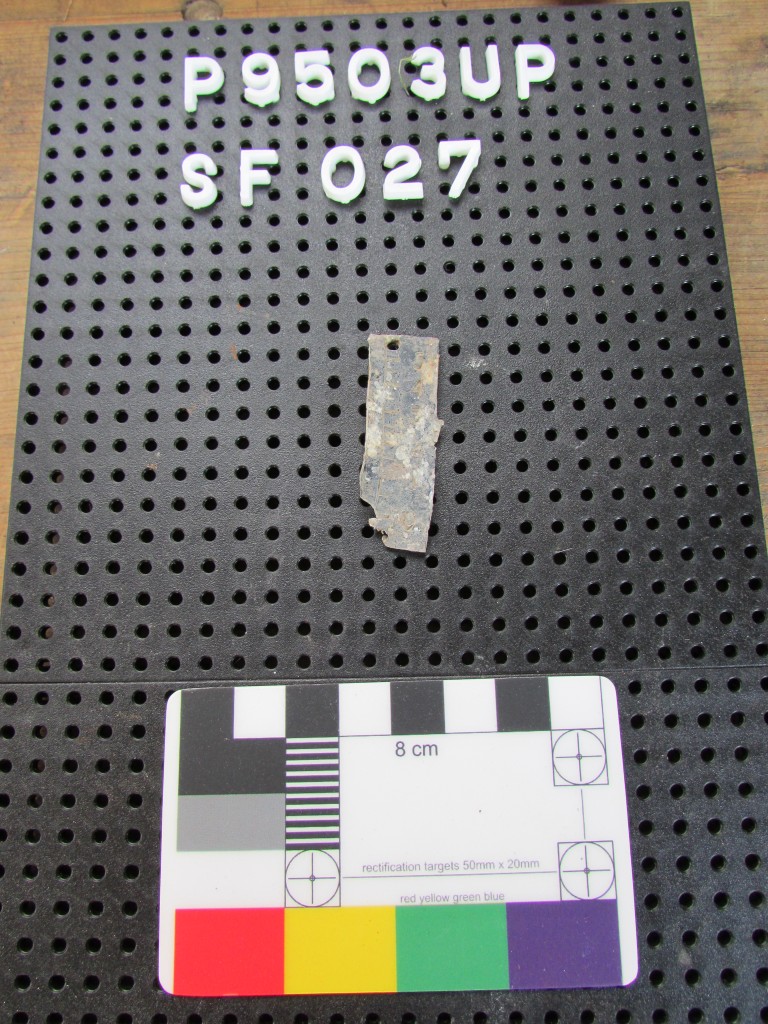
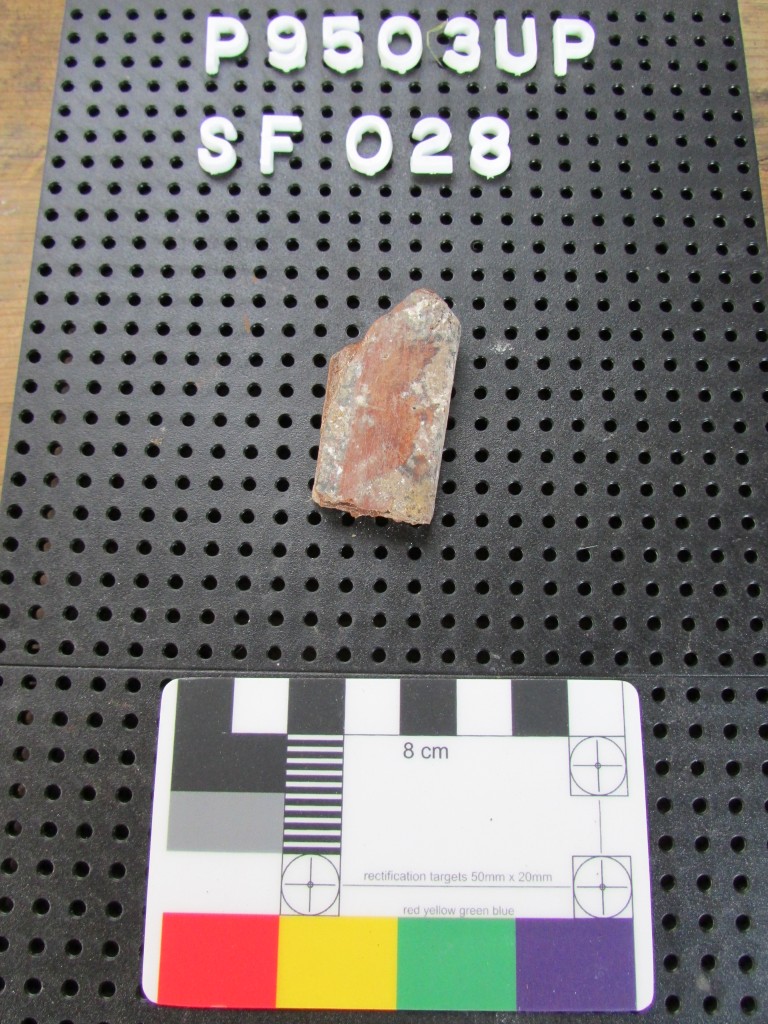 They seem insignificant until you get the experts in and then the bits that look like they should be thrown away actually mean something…
They seem insignificant until you get the experts in and then the bits that look like they should be thrown away actually mean something…
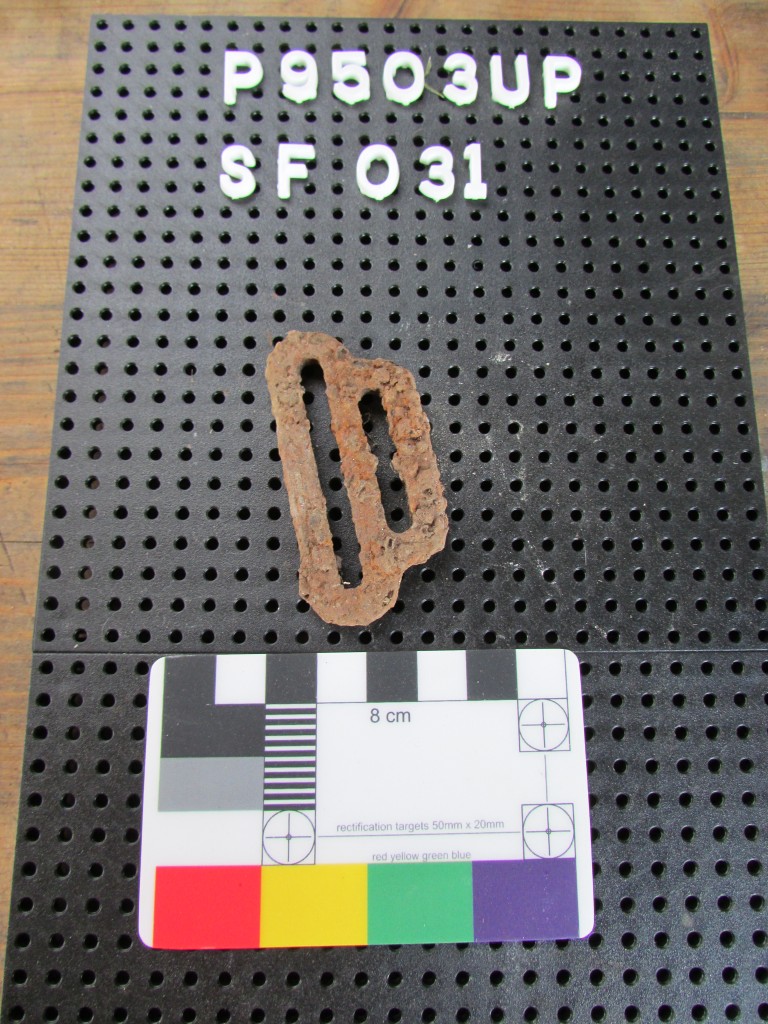
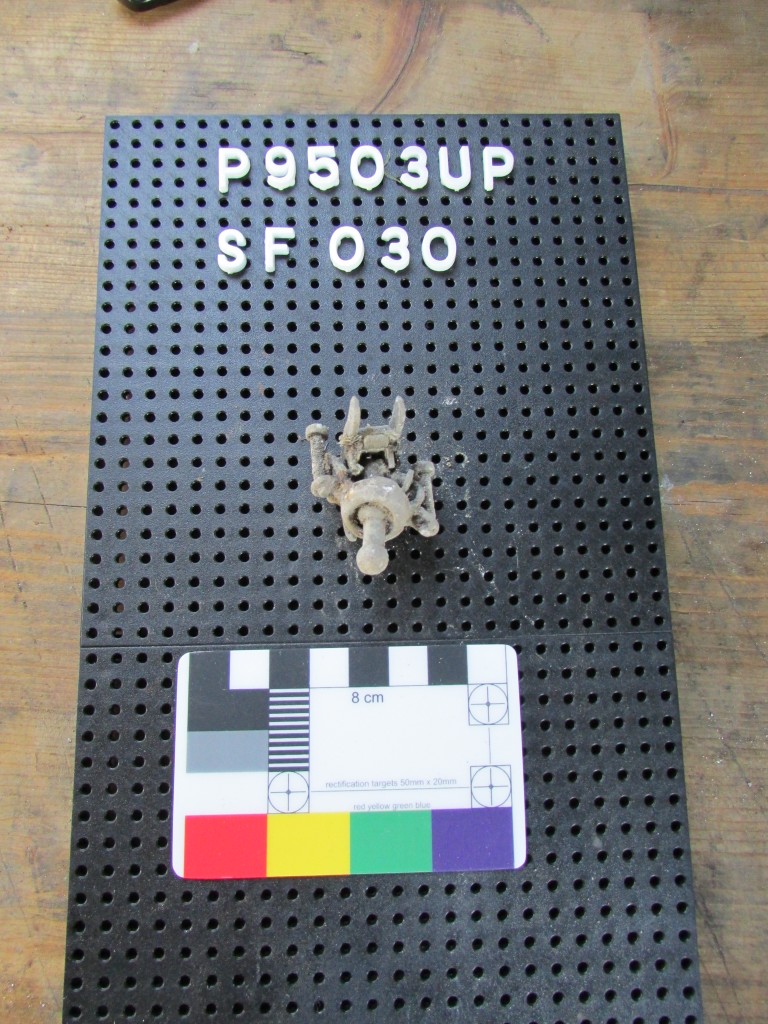 Then we found the flap selector switch…
Then we found the flap selector switch…
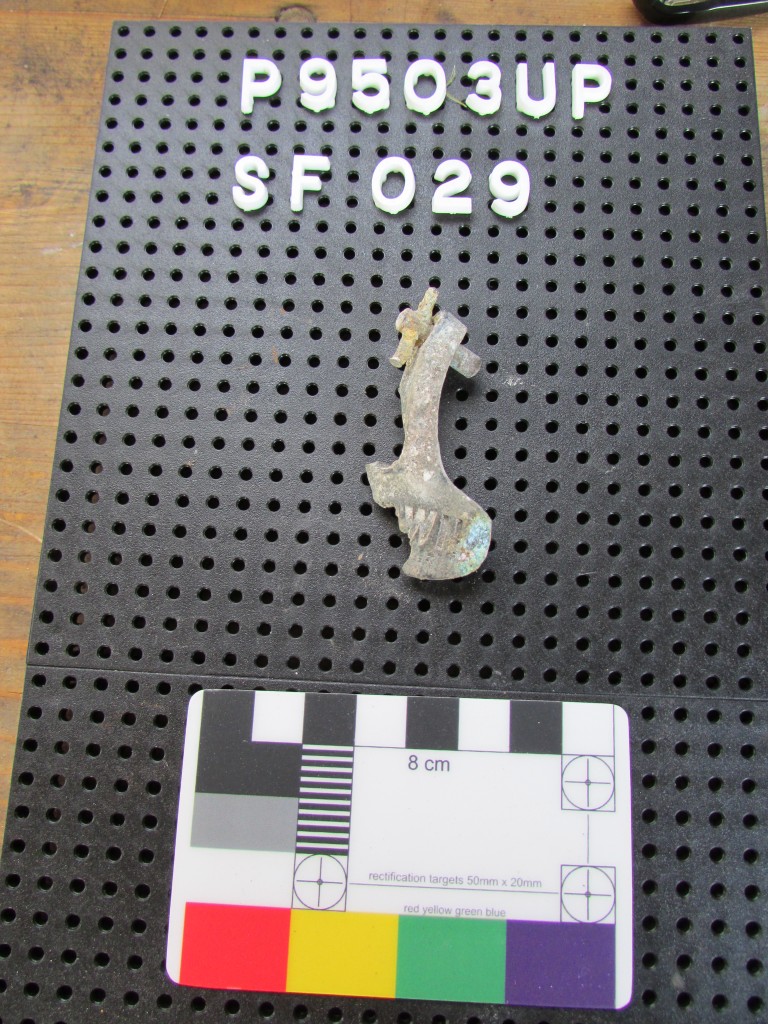 And then the bit that everyone was excited about showed itself after some hard scraping with trowels so as not to damage the item…
And then the bit that everyone was excited about showed itself after some hard scraping with trowels so as not to damage the item…
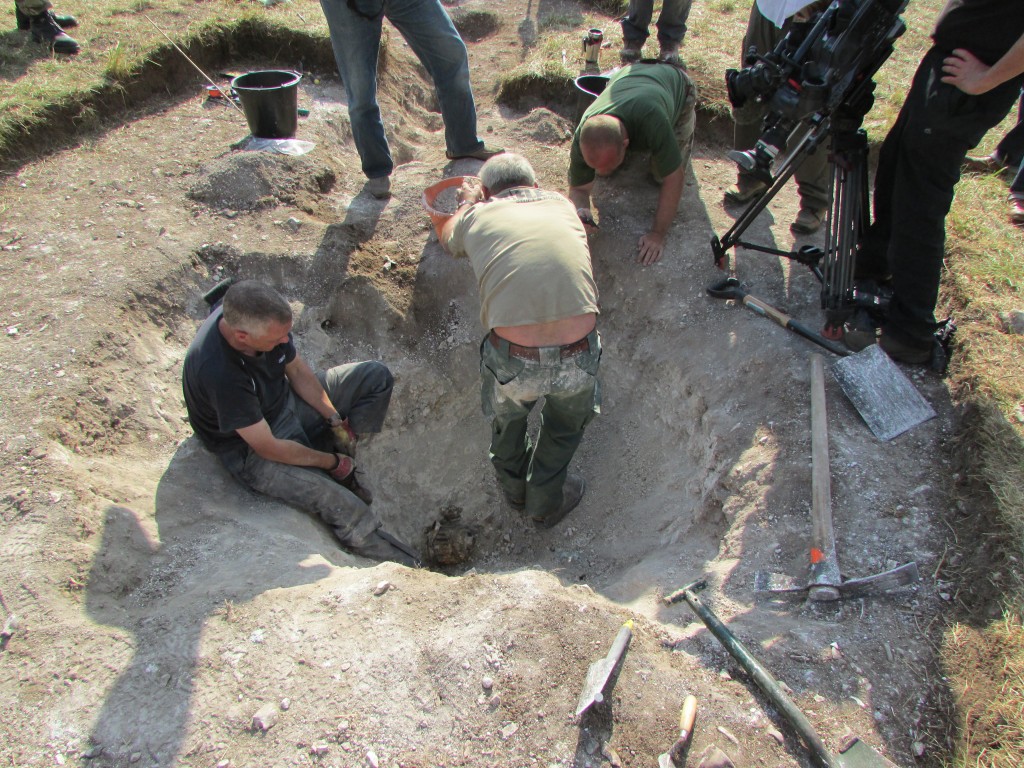 Intrigue surrounded the hole in the ground…
Intrigue surrounded the hole in the ground…
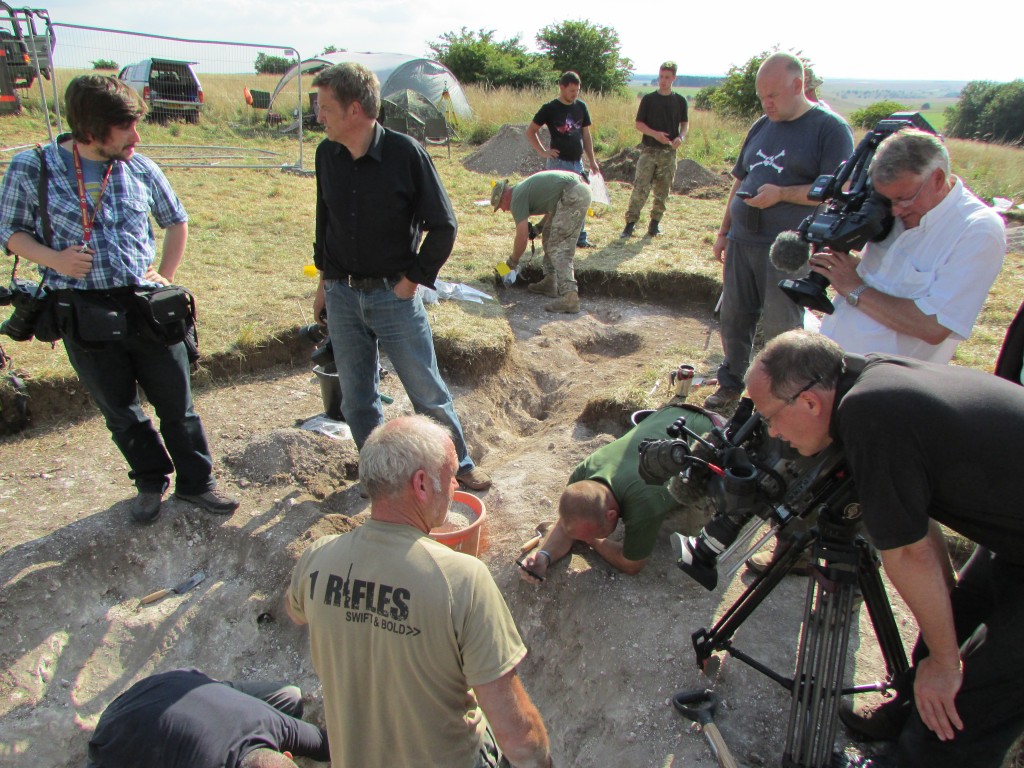 And finally it was ready to be extracted from the chalky ground which had held it since 1940…
And finally it was ready to be extracted from the chalky ground which had held it since 1940…
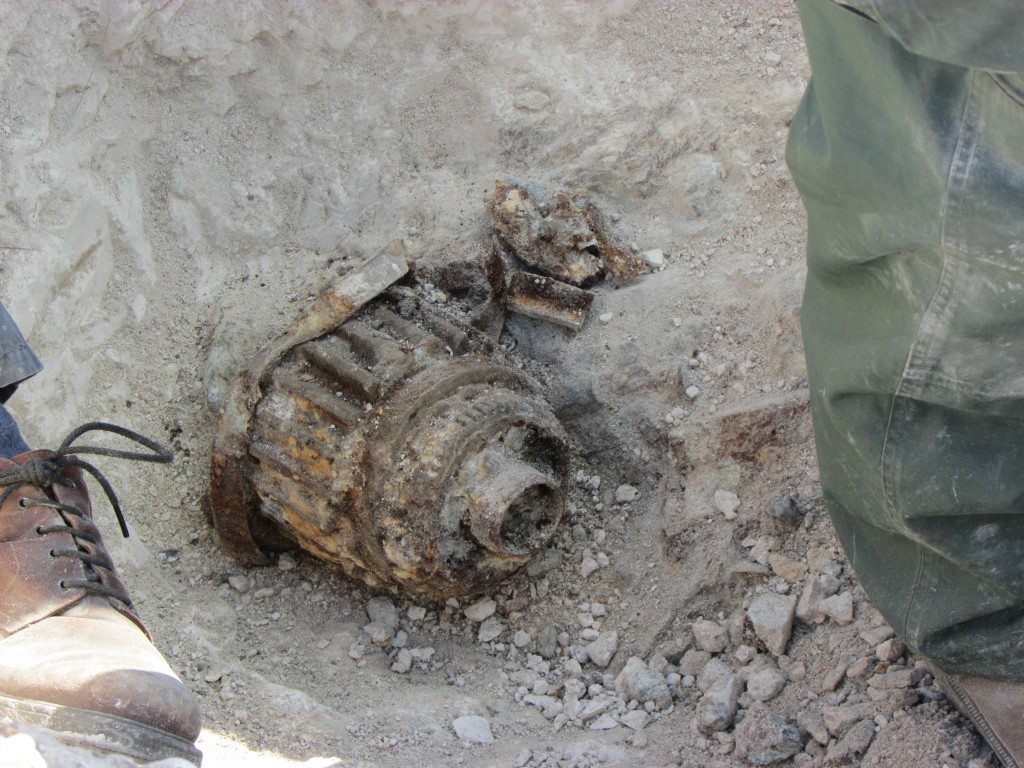 This was the reduction gear for the propeller.
This was the reduction gear for the propeller.
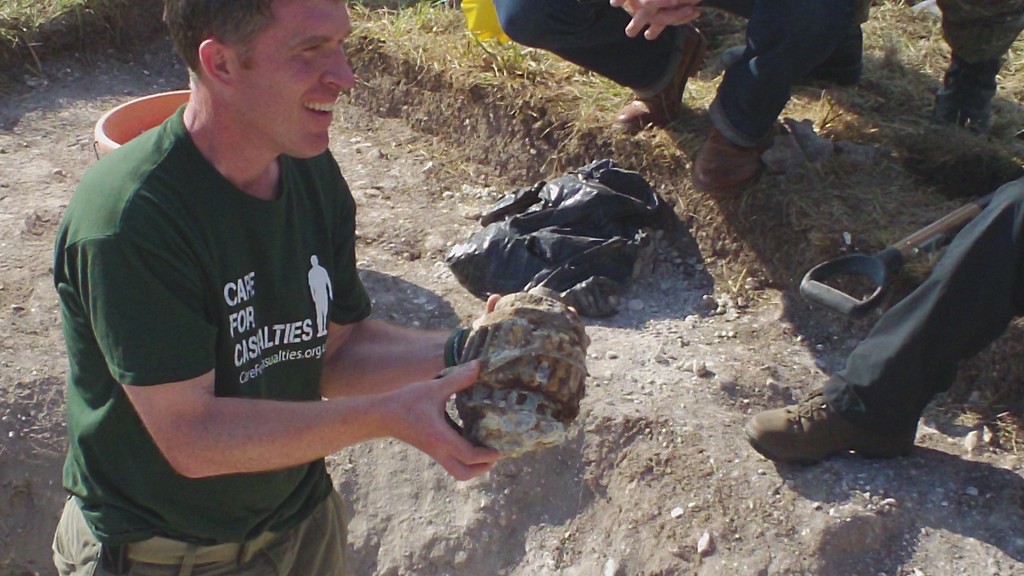 So they were the pictures for day one and day two. Now I shall tell you about day three.
So they were the pictures for day one and day two. Now I shall tell you about day three.
It started for me at three in the morning when I awoke with my bodily functions requiring some attention, and as it is such an effort and long process to get up and sort it out I decided that this would be when I got up. The internet had been really crap as you would expect, and so I figured it would be worth a go to see if I could do the Blog and upload it at that time of the morning. The signal was not too bad and I did manage to get the words at least up on line. After watching the sun rise and the others on the site getting up and wondering around I collard one of the guys to put the cook set on and heat water for washing and cups of coffee, something I can not do on my own for obvious reasons. `Pux` did the food run and set the containers out for people to get their breakfast and then work commenced again. It was on day three that we had several experts on site that would hopefully be able to identify some of the parts and bits we had found. They did indeed know their stuff and threw some light on various pieces which helped me to log them.
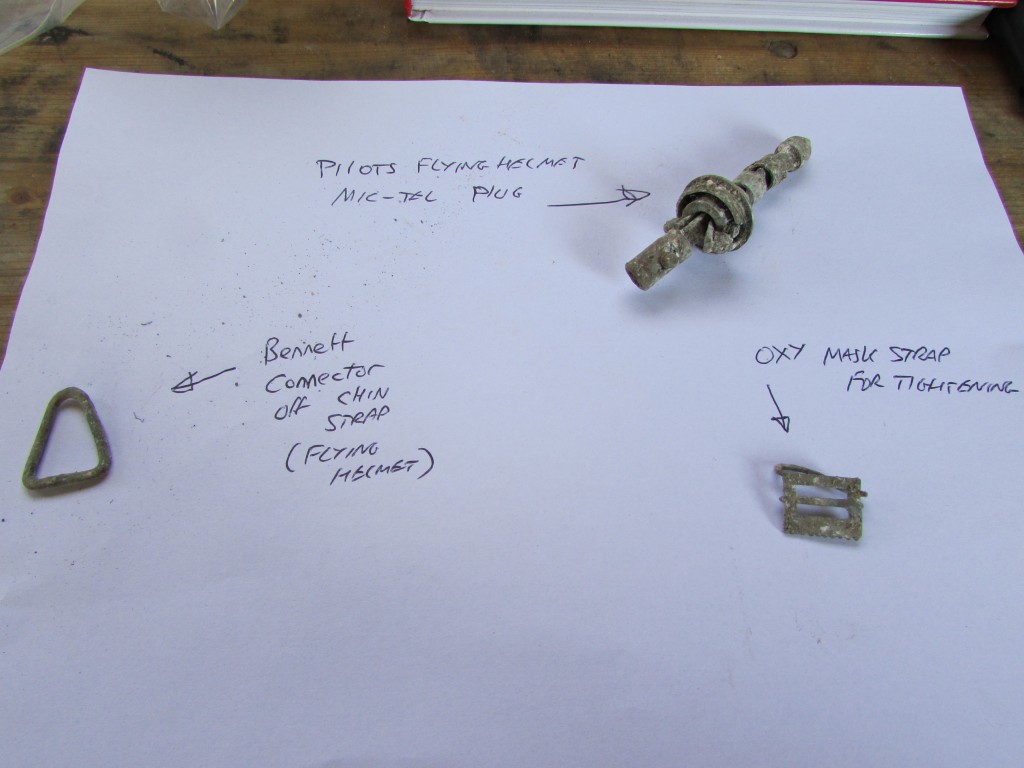 One of the gentlemen who knew their stuff was a guy called Andy Saunders, when he arrived on day one and I spoke to him it got on to the conversation of my having built several Airfix Spitfires. When he returned on day three he told me he had something for me. He returned several minutes later with a book entitled “Spitfire Mark 1 P0375” which was actually written by him! It is about a Spitfire which was found in the sand off France which they restored and it flew again. I am really looking forward to reading it and judging by the inside of the book, I may well be looking to get more of his books as well. I’ll take this opportunity to say a massive “Thank you” to him for the book, it was a fantastic surprise.
One of the gentlemen who knew their stuff was a guy called Andy Saunders, when he arrived on day one and I spoke to him it got on to the conversation of my having built several Airfix Spitfires. When he returned on day three he told me he had something for me. He returned several minutes later with a book entitled “Spitfire Mark 1 P0375” which was actually written by him! It is about a Spitfire which was found in the sand off France which they restored and it flew again. I am really looking forward to reading it and judging by the inside of the book, I may well be looking to get more of his books as well. I’ll take this opportunity to say a massive “Thank you” to him for the book, it was a fantastic surprise.
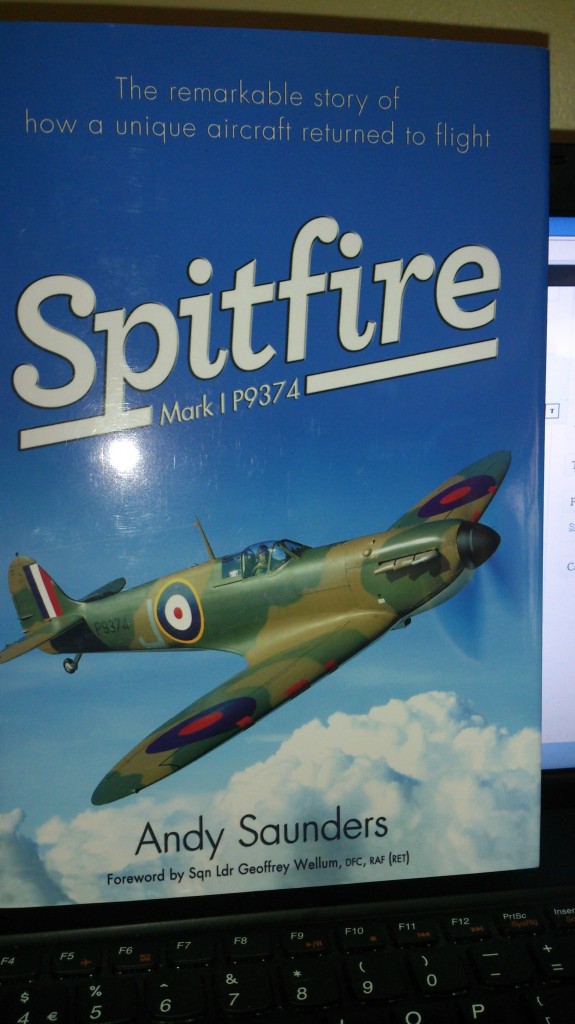 More and more bits recovered from the field were brought in to us…
More and more bits recovered from the field were brought in to us…
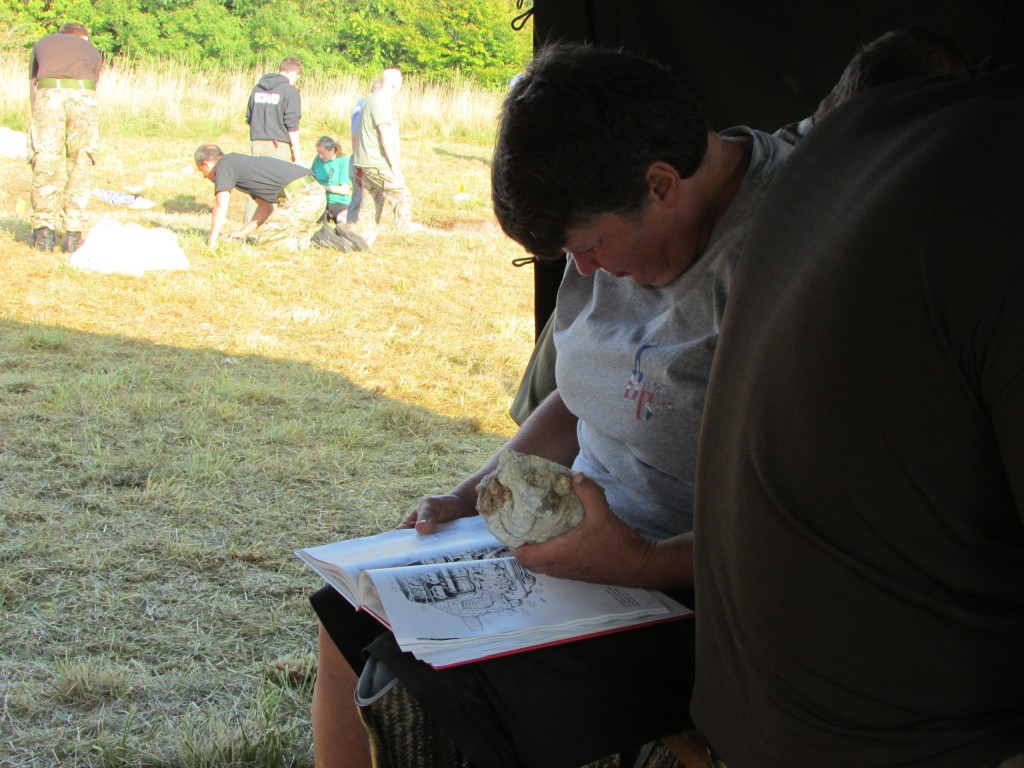 Photograph and log, in this case it is a counter balance for the propeller…
Photograph and log, in this case it is a counter balance for the propeller…
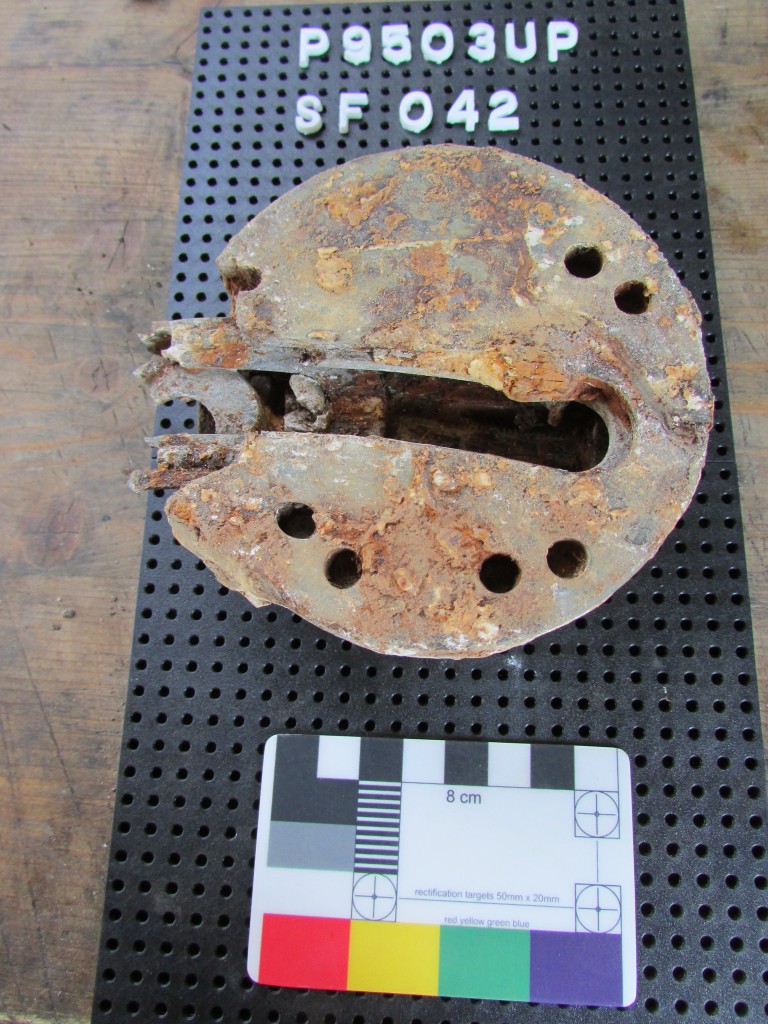 A Dehaviland plate from the fuselage…
A Dehaviland plate from the fuselage…
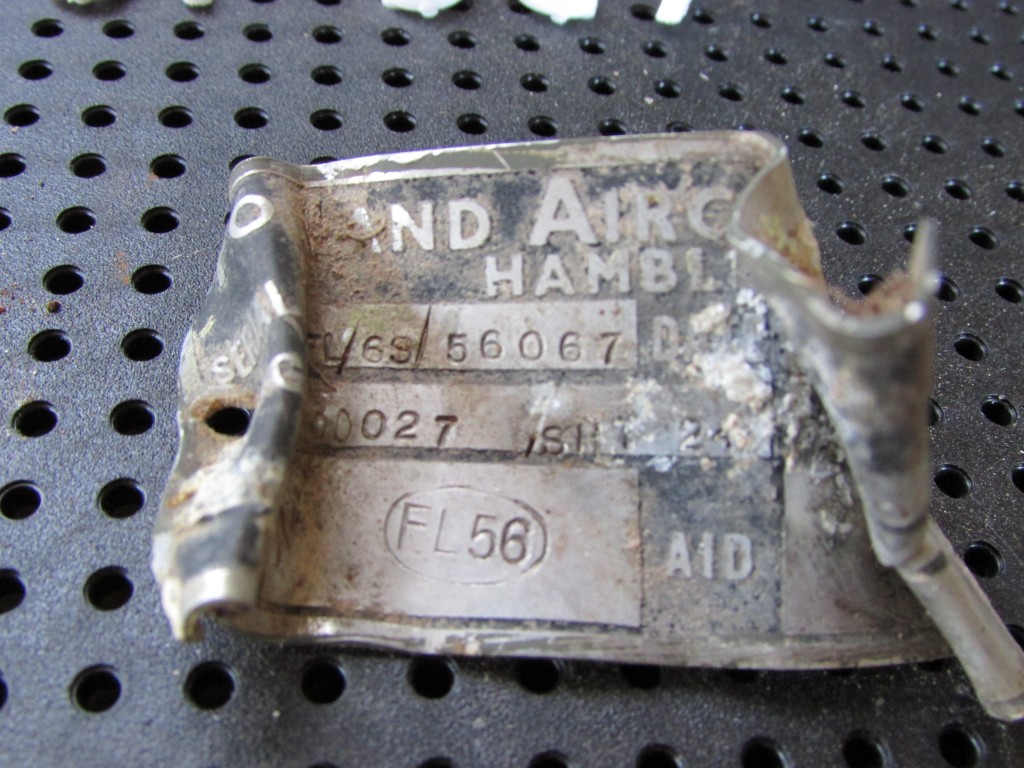 And the reduction gear having been cleaned…
And the reduction gear having been cleaned…
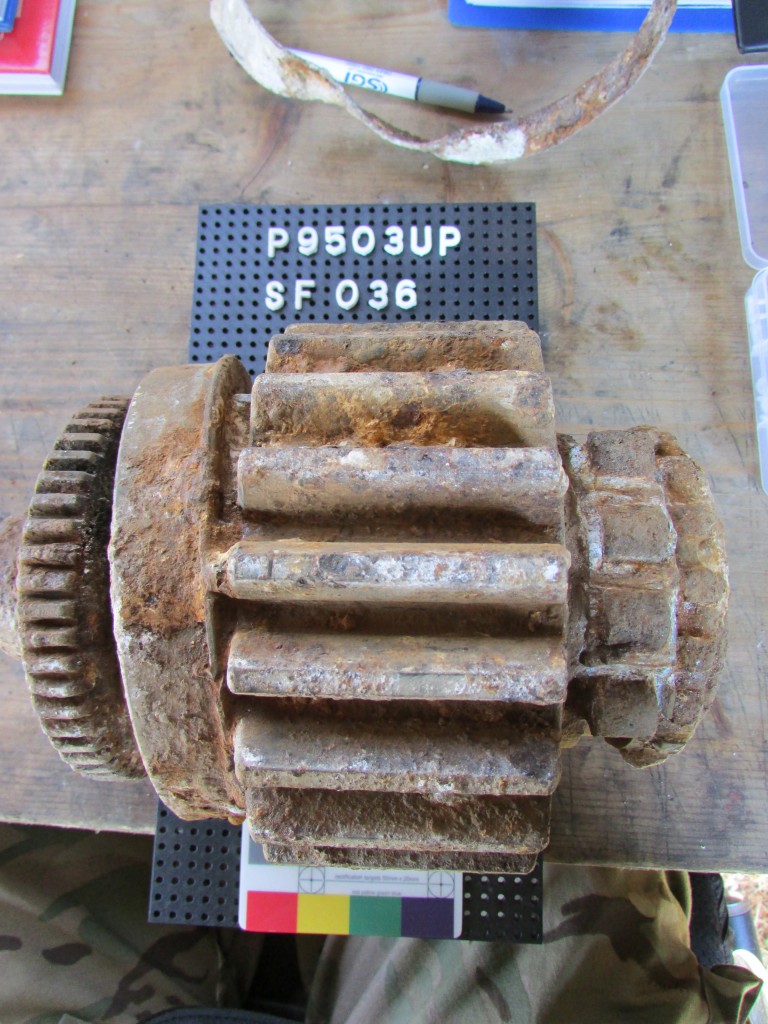 This shows the site from a raised platform (stolen from Graham Moore R.A.F!)…
This shows the site from a raised platform (stolen from Graham Moore R.A.F!)…
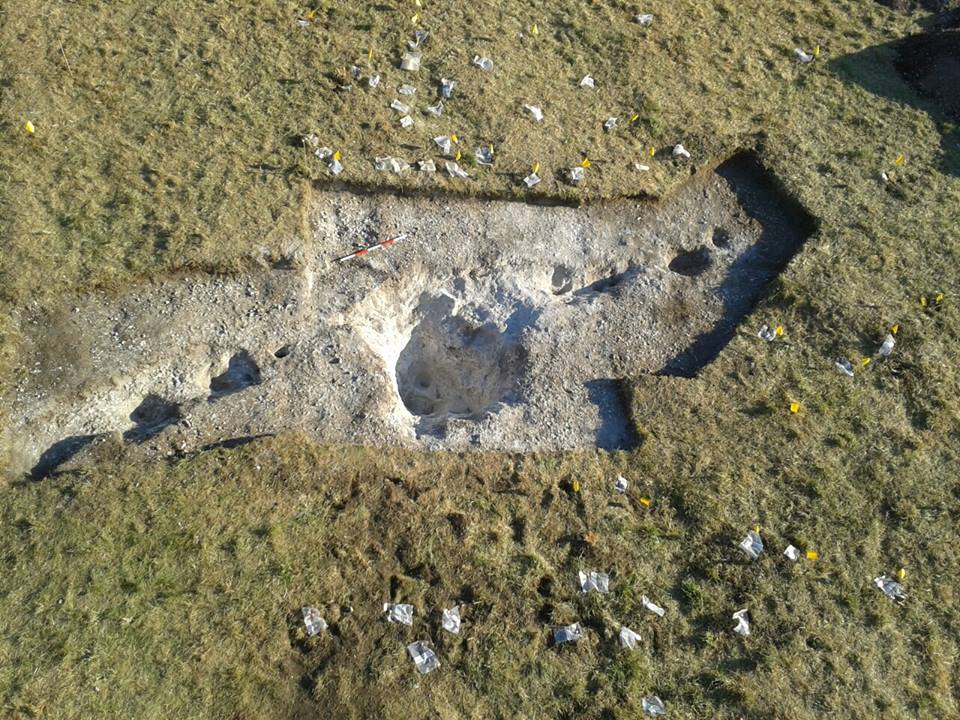 And this is the depth of the hole the reduction gear came out of as modelled by Graham and `Pux`…
And this is the depth of the hole the reduction gear came out of as modelled by Graham and `Pux`…
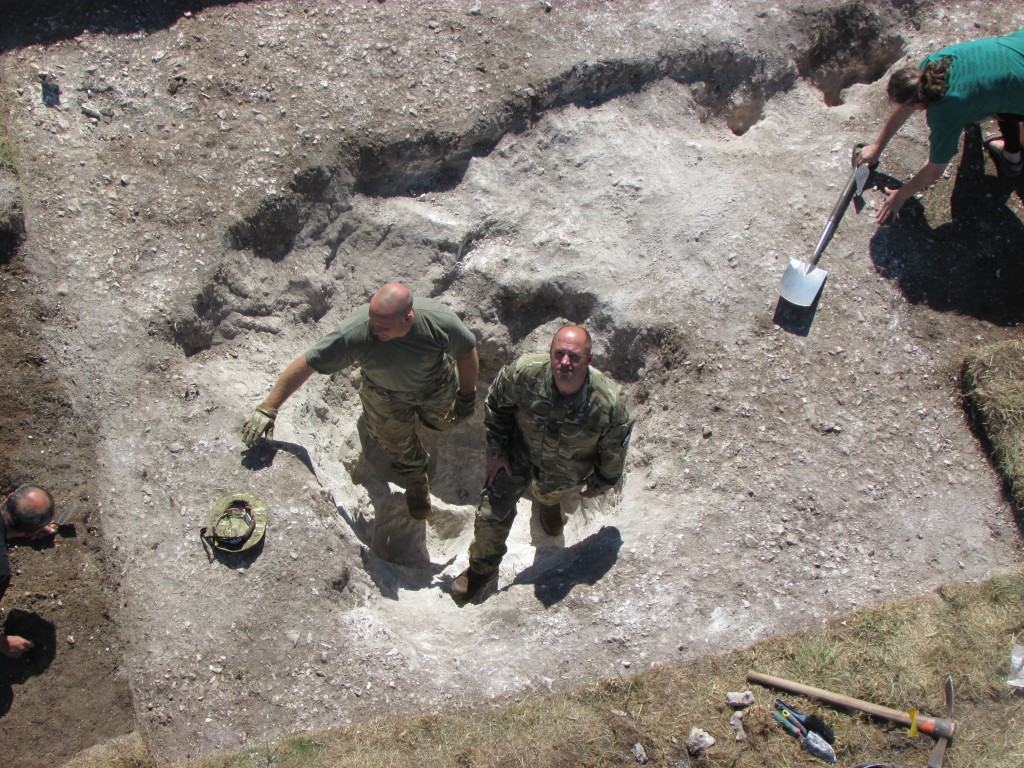 More bits were given in to us to do our thing with but the reduction gear was the biggest part we recovered. Obviously you have to remember that it is a military training area and the aircraft went down in 1940. The Air Force will have gone to the site and recovered the guns early after the crash. Boys will have gone to get souvenirs and good knows how many others have found bits over the years, on top of this the aircraft would have hit the ground at 300 plus mph and there would, I would imagine, have been an explosion of sorts scattering bits everywhere. This is of course assuming the aircraft did not break up on the way down. After the metal detectors found nothing else the decision was made to make it the last day of digging.
More bits were given in to us to do our thing with but the reduction gear was the biggest part we recovered. Obviously you have to remember that it is a military training area and the aircraft went down in 1940. The Air Force will have gone to the site and recovered the guns early after the crash. Boys will have gone to get souvenirs and good knows how many others have found bits over the years, on top of this the aircraft would have hit the ground at 300 plus mph and there would, I would imagine, have been an explosion of sorts scattering bits everywhere. This is of course assuming the aircraft did not break up on the way down. After the metal detectors found nothing else the decision was made to make it the last day of digging.
Day four, (today), the survey team would make one last survey of the area and make notes on reports of the site of any `hits` for another dig in the future. Today then, the site would be collapsed. Tents down, equipment away and depart ready for the hole to back filled tomorrow, (Friday). To that end I left site on the afternoon of day three as I would be more of a hindrance than a help as I can not help with the tents or lugging equipment round. So I said goodbye to the old friends I have there, Dave Hart, “Captain” Paul and “Kenny” being just three and to the new ones I have made, “Lloydy” being just one of them who I really did have a good laugh with (thanks mate). Finally then with the “Goodbye’s” done, `Pux` and Graham helped me in to the Hilux and while `Pux` lifted the power chair on the the truck, Graham and Paul loaded my other belongings and chairs in to the truck and the Hilux. With us loaded we headed off to the RV point where my Wife would be meeting us.
Upon arrival at the RV, my chairs and kit were off loaded…
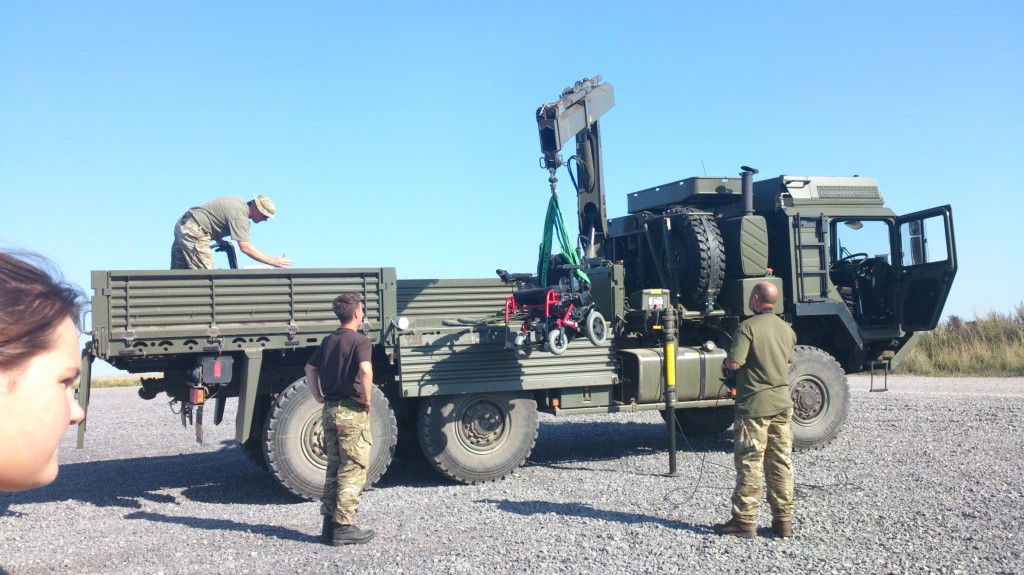 It may seem overkill to you, the reader, seeing the pictures, but there is no way of getting my chairs to the site except by all wheel drive. The equipment that needs to be taken to site requires trucks such as the one shown, just to transport it, so it means that I am able to participate as they have the equipment to help me. While My equipment and I were loaded in to the “Chucklebus”, `Pux` allowed my Son to sit in the cab of the new truck. He has been in the old “4 Tonney’s” plenty of times, but as I am unable to help him in to the trucks any more he had not yet been in one of these.
It may seem overkill to you, the reader, seeing the pictures, but there is no way of getting my chairs to the site except by all wheel drive. The equipment that needs to be taken to site requires trucks such as the one shown, just to transport it, so it means that I am able to participate as they have the equipment to help me. While My equipment and I were loaded in to the “Chucklebus”, `Pux` allowed my Son to sit in the cab of the new truck. He has been in the old “4 Tonney’s” plenty of times, but as I am unable to help him in to the trucks any more he had not yet been in one of these.
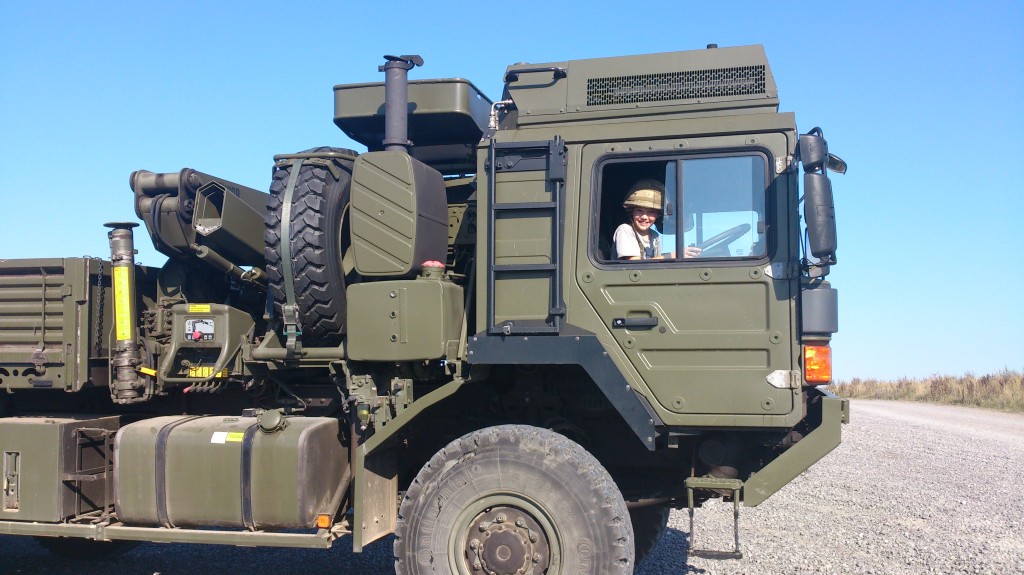 You can see by the smile on his face he was chuffed.
You can see by the smile on his face he was chuffed.
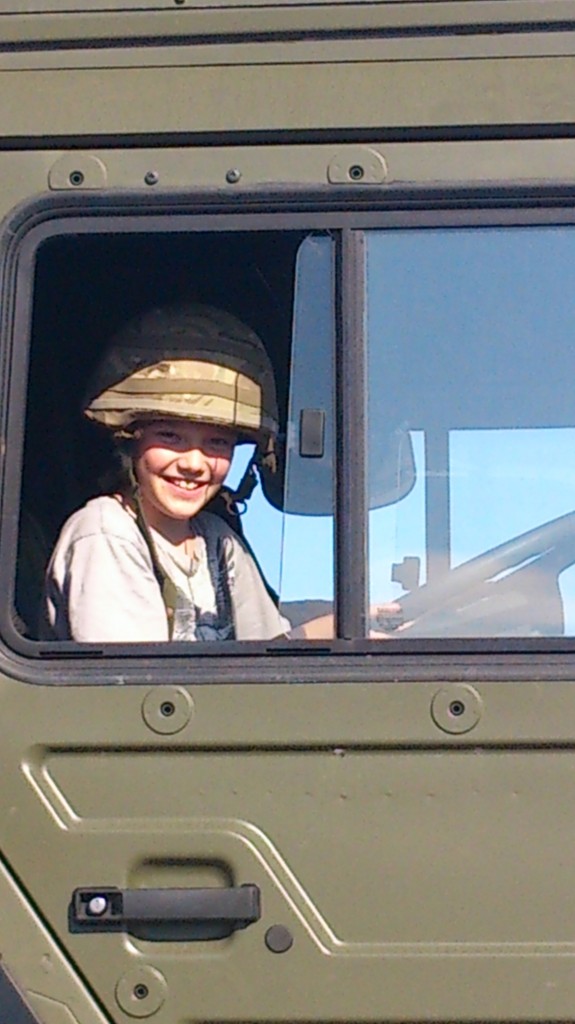 With me all strapped in and the equipment loaded in to the “Chucklebus”, we waved “Goodbye” and headed home.
With me all strapped in and the equipment loaded in to the “Chucklebus”, we waved “Goodbye” and headed home.
My few days away would not have been possible without Richard Osgood from Defence Archaeology Group who invited me on the dig. My Wife for driving me and more importantly collecting me (most would leave me on the Plain I’m sure!). My friend Paul who always shares the accommodation I am in and helps me if I get in to difficulty. The old and new friends on these digs who help make my life a little easier and ultimately rescue me when I get stuck in long grass, undulating terrain or mud (after banter, laughing and generally taking the piss out of me!) And to my friends from the Royal Air Force, Graham and `Pux` who get the task of moving me and my stuff on to and off of the area but don’t worry about doing it. So my first `camping` trip went well. I know now that I can do it and that as long as I could convince someone to put our tent up, my Wife, kids and I could go away as a family camping on a camp site.
I appreciate that this has been a long Blog and I thank those of you who have read it to the end. Hopefully you can see what we have been up to and also, whilst the entire team were not in the photo’s, you get some idea of just how many injured service personnel now take part in Operation Nightingale.
Good evening all.
